Article and photos by Joe Sapia
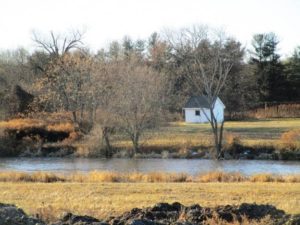
A farm outbuilding in Hopewell Township, Mercer County.
UPPER MILLSTONE RIVER EAGLE NEST: Last year’s pair of bald eagles, “Haliaeetus leucocephalus,” has returned to its nest along the Millstone River corridor on the boundary of Middlesex and Mercer counties. Last year, the nest fledged one eaglet. The state Endangered and Non-Game Species Program (within the Department of Environmental Protection’s Division of Fish and Wildlife) has named Anne Price, a professional naturalist and fellow Monroe, Middlesex County, resident, and me as the volunteer monitors for the nest. The eagles were still in pre-nesting phase, but we expect an egg or eggs to be laid any day now. More good news to follow next week. (In the 2017 state eagles report, http://www.state.nj.us/dep/fgw/ensp/pdf/eglrpt17.pdf, this nest is listed as No. 184.)
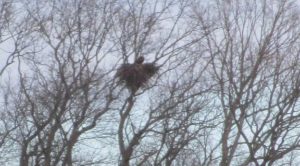
A bald eagle perched on the Upper Millstone River nest on the boundary of Mercer and Middlesex counties. This pair appears ready to lay an egg or eggs soon.
SNOWFALL: The Wednesday, January 17, snowfall in the part of Monroe between Jamesburg and Helmetta, Middlesex County, was about 1.0 inches, bringing the seasonal total to about 17.0 inches. (The seasonal average, measured at New Brunswick about 7.5 miles away, is 25.8 inches. So, we need only about 9 more inches to hit the average and we have about 3 months of snow time left.)
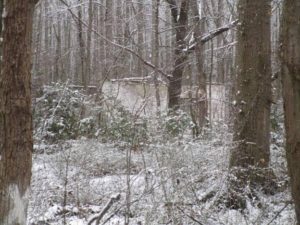
Snowy woods with an abandoned building on Federal Road in Monroe, Middlesex County.
SNOWFENCING: I have talked about snowfencing in open areas before and how it prevents drifting on roadways. Also, I have posted photos. But, perhaps, the post-snowfall scene best describes snowfencing, how snow is deposited on the downwind side. A photograph of the post-snowfall scene:
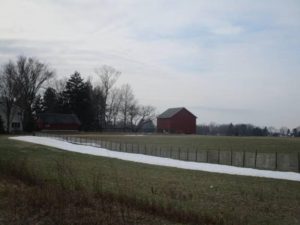
Here, on Main Street in Cranbury, Middlesex County, snow has deposited on the downwind side of the snowfencing. This same concept is used to contain blowing sand on beaches.
CANADA GEESE: I have been seeing a lot of Canada geese, “Branta canadensis,” on farmland, presumably helping themselves to leftover field corn in these fields. And I keep an eye out to see if there is anything else mixed in with these Canadas, perhaps a snow goose, “Chen caerulescens.”
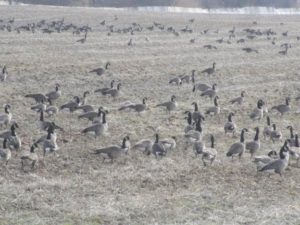
Canada geese on farmland in Cranbury, Middlesex County.
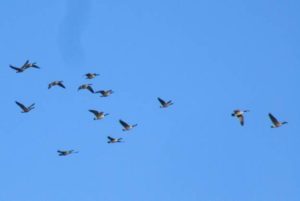
Canada geese flying in Hopewell Township, Mercer County.
BIRDS AROUND THE YARD: We have an incredible world of nature around us in New Jersey. We are at a prime location, where northern and southern animal and plant species meet. One easy thing to do is take time to view the birds in one’s yard. I feed them, using sunflower kernels/hearts nyger. (Last year, though, I stopped feeding birds in the summer, letting them serve as a natural pesticide in my yard. This year, I may extend this feeding ban beyond June, July, and August to a greater gardening period.)
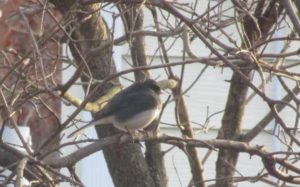
It is a “snowbird” – or dark-eyed junco, “Junco hyemalis” – but it is bundled up against the cold. This junco, in an oak, genus “Quercus,” in my sideyard, has its feathers fluffed to protect it against the cold.
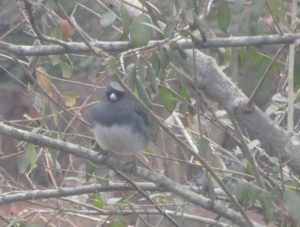
This photograph shows the “dark-eyed” in this dark-eyed junco. This bush in front of my living room window is a fun place to watch birds.
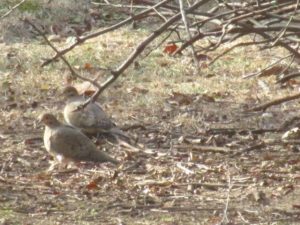
Mourning doves, “Zenaida macroura,” huddled under the flowering quince bush in my backyard.
COASTAL PLAIN BODIES OF WATER: The Jersey Midlands is divided into two geological provinces – the rolling and rocky Piedmont to the west and the flatland, either sandy or gravely, to the east. (The Coastal Plain can be divided into the Outer, or sandy, white soils of the Pine Barrens and beach, and the Inner, the darker, gravely soil conventional farming areas. For the sake of this story, we will talk of the Coastal Plain as one province.) Because of its flatness, there are few, if any, natural bodies of water on the Coastal Plain; Instead, they are human-made, often by dams holding back waterways. In Middlesex County, on the boundary of Helmetta, Monroe, and Spotswood, there is now-dry Lake Marguerite. It was formed by the damming of Manalapan Brook, but has been dry since the 1920s or so. The other day I shot photographs of its old dam.

The remnant of the Lake Marguerite dam on Daniel Road-10th Street on the boundary or Spotswood and Monroe, Middlesex County.

The circa 1906-1907 Lake Marguerite dam.
“OLD JERSEY”: As the Jersey Midlands develop, I am glad to run across “Old Jersey” remnants. Across the street from my house is one of them with an environmental twist – a “Prevent Forest Fires” sign. This sign might be the same one I have seen over all my 61 years. (Just to point out: There has been a different way of thinking on fire. For example, fire is good for the ecology of the Pine Barrens, such as where I live; But it is bad for people.)
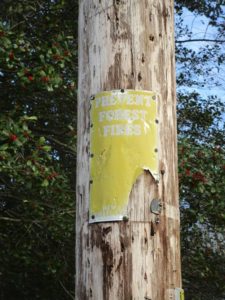
An old “Prevent Forest Fires” sign in my Monroe, Middlesex County, neighborhood.
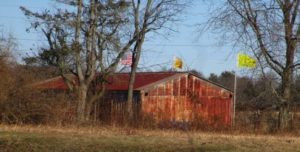
Another “Old Jersey” scene: a farm in Hopewell Township, Mercer County.
SKY VIEWS: This week’s sky views are from Monroe, Middlesex County, and the Manalapan-Freehold Township boundary, Monmouth County.

Monmouth Battlefield State Park on the boundary of Freehold Township and Manalapan, Monmouth County.

Monroe, between Applegarth and Wyckoff’s Mills.
ATLANTIC OCEAN TEMPERATURES: The Atlantic Ocean temperature in New Jersey ranged from about 36 to 37 degrees.
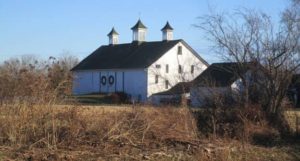
More farming from Hopewell Township Mercer County.
WEATHER: The National Weather Service forecasting office serving the Jersey Midlands is at http://www.weather.gov/phi/.
SUNRISE/SUNSET: For Sunday, January 21, to Saturday, January 27, the sun will rise about 7:10 to 7:15 a.m. and set about 5:05 to 5:10 p.m. For Sunday, January 28, to Saturday, February 3, the sun will rise about 7:05 a.m. to 7:10 a.m. and set about 5:10 p.m. to 5:20 p.m.

The crescent moon over Helmetta Pond, Middlesex County. The crescent moon is waxing toward the January 31 Full Snow Moon.

Ralph “Rusty” Richards, 85-years-old, a mentor of mine in the Pine Barrens around Helmetta, was buried this week in St. James Cemetery in the part of Monroe between Helmetta and Jamesburg, Middlesex County. As his obituary read, “He was an avid woodsman with an extensive knowledge of the local pine barrens….” I left this bough of pitch pine, “Pinus rigida,” the most common pine in the New Jersey Pine Barrens, on Rusty and his wife’s, Mona’s, gravestone. The cemetery is in my neighborhood and Rusty’s grave is a neighbor of my parents’s, Joe Sr. and Sophie Onda Sapia’s, grave. (My maternal family, the Onda-Poznanski family, has known the Richards family for 100 or so years.)
— Joseph Sapia
2018, January 21, Sunday,
A woodsman of the Pine Barrens of Helmetta
Joe Sapia, 61, is a lifelong resident of Monroe — in South Middlesex County, where his maternal family settled more than 100 years ago. He is a Pine Barrens naturalist and an organic gardener of vegetables and fruit, along with zinnias and roses. He draws inspiration on the Pine Barrens around Helmetta from his mother, Sophie Onda Sapia, who lived her whole life in these Pines, and his Polish-immigrant grandmother, Annie Poznanski Onda. He gardens the same backyard plot as did his Grandma Annie and Italian-American father, Joe Sr. Both are inspirations for his food gardening. Ma inspires his rose gardening. Joe is a semi-retired print journalist of almost 40 years. His work also is at @JosephSapia on Twitter.com, along with Facebook.com on the Jersey Midlands page.
Copyright 2018 by Joseph Sapia
Article and photos by Joe Sapia (except where noted)

The Delaware River, iced-over Tuesday, January 2, at Washington Crossing — looking from Mercer County, New Jersey, to Bucks County, Pennsylvania, just upstream of the bridge.
SUB-FREEZING DAYS: After days of sub-freezing cold, how cold was it? Cold enough for a waterway – in this case, the mighty Delaware River — to freeze over.
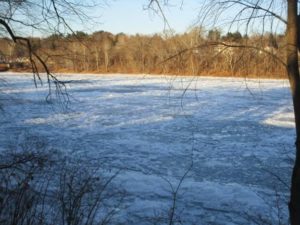
The frozen-over Delaware River Tuesday, January 2, at Washington Crossing, looking from Pennsylvania to New Jersey.

A woman maneuvers Main Street in Cranbury during the Thursday, January 4, snowfall.
SNOWFALL, JANUARY 4: This storm produced a wind-whipped, powdery snow. Snowfall totals reported by National Weather Service:
Burlington County: 3.4 inches at Cinnaminson to 7.5 inches in the Southampton area.
Hunterdon County: 1.9 inches at Readington to 5.8 inches in the Hampton area.
Mercer County: 4.0 inches in the Washington Crossing area to 6.6 inches in the Lawrence area.
Middlesex County: 4.5 inches in the South Brunswick area to 9.6 inches at Cheesequake.
Monmouth County: 9.0 inches at Keyport to 18.0 inches in the West Long Branch area.
Ocean County: 12.5 inches in the Brick area to 18.3 inches in the Berkeley area.
Somerset County: 3.0 inches in the Montgomery area to 5.8 inches in the Franklin area.
(These totals are for these specific stations and may not be complete highs and lows for the counties.)

A snowplow pushes snow on Stockton Avenue in Jamesburg, Middlesex County, in the Thursday, January 4, snowfall.
SNOWFALL FOR THE SEASON: With the January 4 snowfall, my house in Monroe, Middlesex County, has had 16 inches of snow, so far this season. The seasonal average at New Brunswick, Middlesex County, or about 7.5 miles from my house, is 25.8 inches. The January 4 snowfall produced 7 inches at my house.
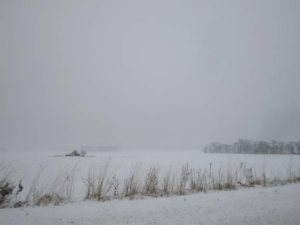
A wind-whipped, snowy field in Monroe, Middlesex County.
WALKING THE SNOWY WOODS: During the Thursday, January 4, storm, I set out from my house about 4:30 p.m., hitting the woods across the street, not wanting to pass up the pristine snowy woods. It was a brief walk, only about 45 minutes from shortly before sunset to shortly after. But I was glad I got to spend a few minutes shooting pictures of nature’s beauty and relaxing in the woods, before shoveling snow. (Weather conditions: Overcast, estimated temperature of 27 degrees, dew point of 5.5 to 6, wind sounding like a freight train.) I got thinking about this short time in the woods. Normally, I do not consider it a hike unless I do at least 3 miles. Perhaps I should re-focus and think about the mental part of the woods and try to get out there daily, even if for only a short time.
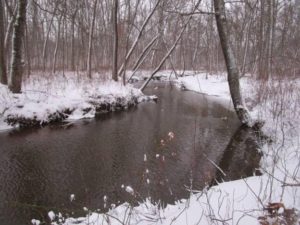
The Old Swimming Hole on Manalapan Brook in Monroe, Middlesex County.
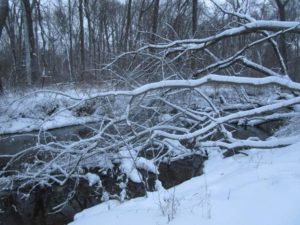
A snow-covered treefall on Manalapan Brook in Monroe, Middlesex County.
SNOW AND THE LAY OF THE LAND: Take advantage of any snow cover. Where there is no snow cover, the woods presents itself as a homogenous picture of earth tones or green leaves – or both. But add a snow-cover; or, better, snow-cover and snow clinging to vegetation; or better yet, snow-cover, snow clinging to vegetation, and foliage and the depth and roll of the land stand out.

The snow-dusted Pine Barrens around Helmetta, Middlesex County – here, specifically, an East Brunswick section of the Jamesburg Park Conservation Area. With the snow contrasting against the earth tones of the woods, it is easy to see the roll of the land.
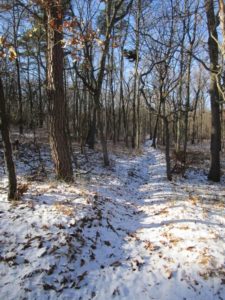
A firecut, plowed by the state Forest Fire Service before a controlled burn here in the Jamesburg Park Conservation Area, is easly seen, along with the rest of the lay of the land, thanks to snow contrasting with the woods’s earth tones.
VOICES FROM AFIELD, EAGLE: Patty Byrnes Lang of Monroe, Middlesex County, checked in with photographs of a bald eagle, “Haliaeetus leucocephalus,” she saw on the boundaries of Monroe, Cranbury/Middlesex County, and East Windsor/Mercer County. In New Jersey, bald eagles are “endangered,” or in immediate jeopardy, as breeders and “threatened,” meaning if conditions persist they could become endangered,” in general. Patty described one encounter, “I caught a glimpse of him in one of the trees on the left. We got to watch as he flew off the branch he was on, circled the field, and landed on another tree.” Based on its coloring, this is an adult. It could be one of the adults that had a nest last year nearby, along the Millstone River in Monroe. This is the time of year eagles begin working on nests.
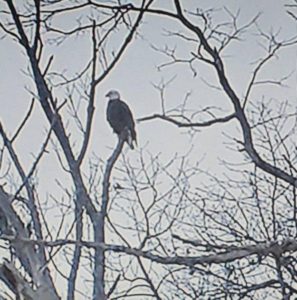
A bald eagle on the boundary of Middlesex and Mercer counties, along the border of Monroe/Middlesex, Cranbury/Middlesex, and East Windsor/Mercer. (Photo copyright 2017 by Patty Byrnes Lang)
VOICES FROM AFIELD, BLUEBIRD: Bob Kane of Cranbury, Middlesex County, checked in with a photograph of an eastern bluebird, “Sialia sialis,” taken in his town. This one is easily identifiable as a male, because of the bright coloring.

A male eastern bluebird at Cranbury, Middlesex County. (Photo copyright 2018 by Bob Kane)
RANCOCAS CREEK: The Rancocas Creek watershed is 360 square miles. It is the only major waterway that flows into the Delaware River from the Pine Barrens. And, despite being freshwater, has a tidal effect; The Delaware River has a tidal effect on its freshwater as far north as Trenton.

Low tide on Rancocas Creek, looking upstream on the boundary of Mount Laurel, Willingboro, and Westampton, all in Burlington County. Although this is freshwater, there is a tidal effect on the Delaware River and its tributaries as far north as Trenton.
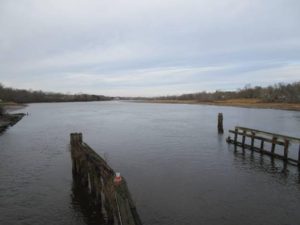
Rancocas Creek, looking downstream at the boundary of Mount Laurel, Willingboro, and Westampton, all Burlington County.
GARDEN WRITING COURSE: This spring, I will be teaching non-fiction writing again at the Princeton Adult School. This time, it will be “Garden Writing,” five sessions on Thursdays, 7 p.m. to 9 p.m., from March 22 to April 26. The class description: “Look at your garden and yard in a different way – through your words. Record your memories in the garden and yard through the essay and vignette. This writing-intensive course has weekly take-home assignments, with the instructor returning critiqued papers. Students will learn writing components, outlining, grammar, style, interviewing, and the importance of resources such as dictionaries and stylebooks – with all assignments focusing on our vegetables, flowers, yards – or afield, if you wish. In-class discussion will cover good examples turned in by students, common problems, and concerns. Feel free to use the class to write a chapter a week of a dream project, work on getting published, keep a journal, or just have fun.” The class costs $99. Enrollment at http://www.ssreg.com/princeton/classes/classes.asp?catID=3679.
ATLANTIC OCEAN TEMPERATURES: The Atlantic Ocean temperature at in New Jersey on the January 6-7 weekend ranged from about 29 to 30 degrees.
WEATHER: The National Weather Service forecasting office serving the Jersey Midlands is at http://www.weather.gov/phi/.
SUNRISE/SUNSET: For Sunday, January 7, to Saturday, January 13, the sun will rise about 7:20 a.m. and set about 4:45 to 4:50 p.m. For Sunday, January 14, to Saturday, January 20, the sun will rise about 7:15 to 7:20 a.m. and set about 4:55 to 5 p.m.
PENNSYLVANIA FARM SHOW: The Pennsylvania Farm Show continues through Saturday, January 13. It is a real-deal show of farming life, not faux farming. So, it has animals, tractors, food preparation, food to buy, gardening displays, and exhibitions. Visitors can get up close to it all. And check out the butter sculpture! (Unfortunately, I will miss the show this year. I had plans to go Wednesday with friends Jimmy and Kathy Krygier of Krygier’s Nursery in South Brunswick, Middlesex County, but work called. I am disappointed, because I look forward to this show.) More information at http://www.farmshow.pa.gov.
COVERING THE WEATHER: During my 31 years as a reporter at the Asbury Park Press, I never saw fellow Metro reporters whine so much about covering something than about weather stories. Me, just the opposite. I loooooooved weather stories. Still do. Was out most of Thursday, January 4, chasing the snow.

Joey on the job, here Tuesday, January 2, photographing the iced-over Delaware River at Washington Crossing, Mercer County.. (Photo copyright 2018 by Pamela B. Roes)
Joe Sapia, 61, is a lifelong resident of Monroe — in South Middlesex County, where his maternal family settled more than 100 years ago. He is a Pine Barrens naturalist and an organic gardener of vegetables and fruit, along with zinnias and roses. He draws inspiration on the Pine Barrens around Helmetta from his mother, Sophie Onda Sapia, who lived her whole life in these Pines, and his Polish-immigrant grandmother, Annie Poznanski Onda. He gardens the same backyard plot as did his Grandma Annie and Italian-American father, Joe Sr. Both are inspirations for his food gardening. Ma inspires his rose gardening. Joe is a semi-retired print journalist of almost 40 years. His work also is at @JosephSapia on Twitter.com, along with Facebook.com on the Jersey Midlands page.
Copyright 2017 by Joseph Sapia
Article and photos by Joe Sapia
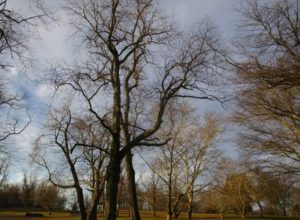
Soft morning sunlight contrasts with threatening skies at the high ground of Thompson Park in Monroe, Middlesex County.
A popular winter activity for generations at Thompson Park is sledding from the high ground toward the low ground around “Jamesburg Lake” (properly Lake Manalapan). The 30-acre lake is formed by the damming of Manalapan Brook at Jamesburg. Remember, there are few, if any, natural bodies of water on the Coastal Plain.

Sledding at Thompson Park in Monroe, Middlesex County, via my 2001 folk art Christmas card.
SNOWFALL: The Saturday, December 30, snowfall of 1.0 inch at my house in the part of Monroe between Helmetta and Jamesburg, Middlesex County, brought the season’s total to 9.0 inches. The seasonal average for New Brunswick, Middlesex County, about 7 miles away, is 25.8 inches. Elsewhere in the Midlands, according to the National Weather Service, with these readings based on what had been reported by reliable spotters at the end of the snowfall and perhaps not comprehensive: Burlington County: a high of 2.5 inches at Florence to a low of 1.5 inches at Moorestown; Hunterdon County: 1.0 inch in Lebanon to .8 inches at Whitehouse Station; Mercer County: 3.2 inches in Hamilton to 2.5 inches in Ewing; Monmouth County: 2.8 inches in the Howell area to .9 inches in Shrewsbury; Somerset County: 1.0 inch in Basking Ridge to .8 inches in Bridgewater; Ocean County: 3.3 in Jackson to 1.5 inches in Toms River.
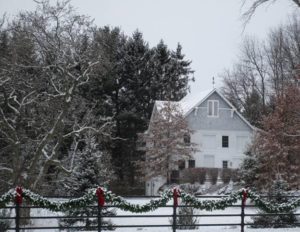
Main Street in Cranbury, Middlesex County, in the Saturday, December 30, snowfall.
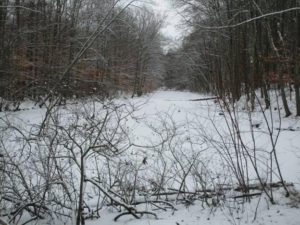
Iced-over and snow-covered Devil’s Brook on the boundary of Plainsboro and South Brunswick, Middlesex County.
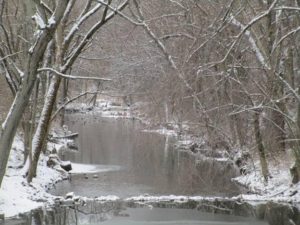
Cranbury Brook as it drains Brainerd Lake (“Cranbury Lake’) in Middlesex County.
SAFE ICE: This time of year, and especially in the hard freeze the Jersey Midlands is in the midst of, we may be tempted to walk out on ice or go skating on it. Be careful! My rule of thumb is the ice must be at least 4-inches-thick. But various factors could come into play, such as warming temperatures, honey-combing, and running water. So, additionally, I look for crystal clear ice or blue-white ice. I am careful of melting ice, snow insulating ice, channels that may run through bodies of water, and fragile ice where water meets land or vegetation.
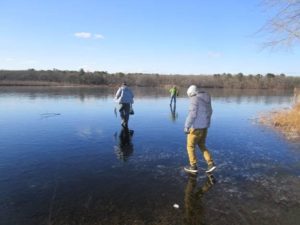
Anglers on an iced-over Helmetta Pond.
ICE SAFETY: If ice is breaking underneath, displace your weight by lying flat. For would-be rescuers, follow this order: throw (a line or flotation device), row (a boat to the person), go (yourself only as a last resort). Probably the soundest advice is to immediately seek help from expert rescuers.
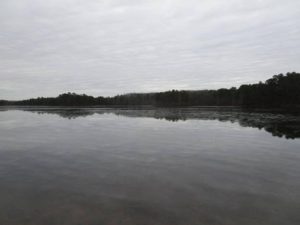
Prospertown Lake in Jackson, Ocean County. The lake is at the northern extreme of the main Pine Barrens.
SWAMP-WALKING: With the sub-freezing high temperatures for an extended period, this is what I look for — a good freeze of the swamps, allowing access to otherwise difficult places to get to. I love swamps!
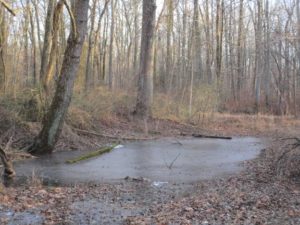
An iced-over wet area in the Manalapan Brook floodplain in Monroe, Middlesex County.
SWAMP-WALKING, No. 2: I started off into the woods across the street from my house – in the Pine Barrens of Monroe, Middlesex County – to do some swamp-walking in the Manalapan Brook floodplain. I did do some, but I got sidetracked when I noticed the abundance of winterberry, genus “Ilex.” I did not get around to making a Christmas wreath or swag, which I decorate with winterberry, but I wound up gathering winterberry to display on its own. I came home with a nice bundle. (To conserve, I broke only one branch from each selected bush.)

Winterberry from the swamp hardwood forest of the Manalapan Brook floodplain on display on my antique kitchen table.
SNOW GEESE: I finally saw some snow geese, “Chen caerulescens,” down from the Arctic as I was driving along the Mercer County-Middlesex County boundary on the border of East Windsor, Cranbury, and Monroe. They were easy to identify by their white bodies and black-tipped wings. There were only a few, rather than a flock. I took a few minutes to see if they were joining a flock on some farmland, but I was going to work and had limited time, finding nothing in my quick search.
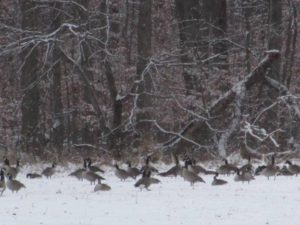
Canada geese, “Branta Canadensis,” is a snow-covered field in South Brunswick, Middlesex County.
ATLANTIC OCEAN TEMPERATURES: The Atlantic Ocean temperature at Sandy Hook on December 30-31 weekend ranged from about 30 to 35 degrees.

A quiet December Atlantic Ocean beach, looking from Avon-by-the-Sea to Asbury Park, Monmouth County.
MOON: The next full moon, the Full Moon After Yule, is January 1, New Year’s Day.
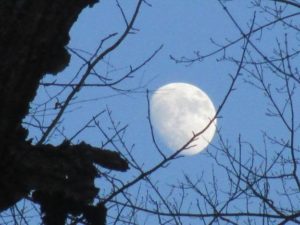
The near-full moon over the swamp hardwood forest of the Manalapan Brook floodplain in Monroe, Middlesex County.
SUNRISE/SUNSET: For Sunday, December 31, to Saturday, January 6, the sun will rise about 7:20 a.m. and set about 4:35 to 4:40 p.m. For Sunday, January 7, to Saturday, January 13, the sun will rise about 7:20 a.m. and set about 4:45 to 4:50 p.m.
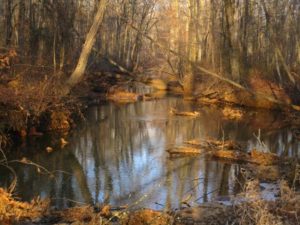
Soft sunlight on Manalapan Brook in Monroe, Middlesex County, as it flows toward Helmetta and Spotswood, also in Middlesex County.
Joe Sapia, 61, is a lifelong resident of Monroe — in South Middlesex County, where his maternal family settled more than 100 years ago. He is a Pine Barrens naturalist and a gardener of organic vegetables and fruit, along with zinnias and roses. He draws inspiration on the Pine Barrens around Helmetta from his mother, Sophie Onda Sapia, who lived her whole life in these Pines, and his Polish-immigrant grandmother, Annie Poznanski Onda. He gardens the same backyard plot as did his Grandma Annie and Italian-American father, Joe Sr. Both are inspirations for his food gardening. Ma inspires his rose gardening. Joe is a semi-retired print journalist of almost 40 years. His work also is at @JosephSapia on Twitter.com, along with Facebook.com on the Jersey Midlands page.
Copyright 2017 by Joseph Sapia
Article and photos by Joe Sapia
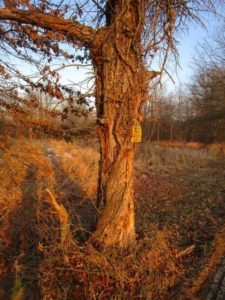
Soft, end-of-the-day sunlight bathes this tree and field on the Pennington-Hopewell Township border, Mercer County. Notice the thick vine – poison ivy, “Toxicodendron radicans” – climbing the tree.
DRIVE-BY NATURALIST, GREAT BLUE HERON: As I was passing Carnegie Lake, which is in the area of Princeton, Mercer County, and Kingston, Somerset-Middlesex counties, I figured I would shoot a photograph of the winter-quiet lake. Quiet? Wrong! As I arrived, a great blue heron, “Ardea herodias,” flew from left to right, landing at the lake. I heard a squawk or squawks, with this heron and another confronting each other, perhaps because these solitary hunters of fish and other aquatic life did not want to share a territory. One flew off, while the other stayed put, providing a subject for my photographs.

As I arrived at Carnegie Lake on the Princeton, Mercer County-Kingston, Middlesex-Somerset counties border, a great blue heron flew in.
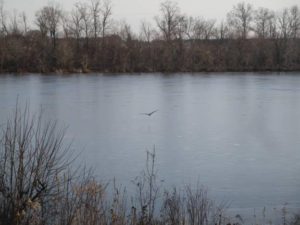 Then, there was a confrontation between two great blues, with one flying off.
Then, there was a confrontation between two great blues, with one flying off.

Remaining was one blue heron, who cooperated nicely for photographs.
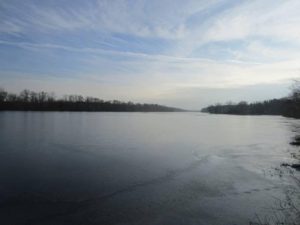
As for the winter calm of Carnegie Lake, it, otherwise, was there.
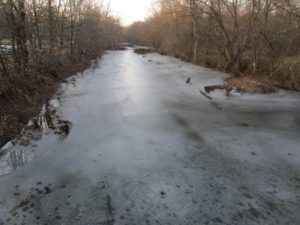
STONY BROOK: Stony Brook meanders for about 22 miles from the Ringoes area of Hunterdon County to the Princeton area of Mercer County, where it empties into the Millstone River. The brook drains approximately 65 square miles.
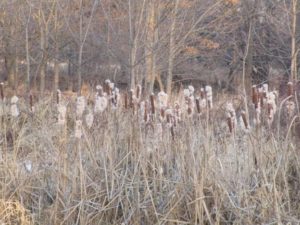
Punks, or cat-tails, genus “Typha,” with their fluffing-out seed heads, in the Stony Brook floodplain in the Pennington-Hopewell Township area, Mercer County.
IF YOU CANNOT GET TO THE ECOSYSTEM, BRING THE ECOSYSTEM TO YOU: Two geological provinces comprise the Jersey Midlands, the rolling hills and rocky Piedmont to the west and the flat, either gravelly or sandy, Coastal Plain to the east. Drive along the flat farmland on the Cranbury-Plainsboro border in Middlesex County and look west to the Princeton area hills in Mercer County, for example, and one would be looking from the Coastal Plain to the Piedmont. So, I was driving through the Pine Barrens around Helmetta and noticed a red shale pile of dirt, dumped on the side of the road in the Jamesburg Park Conservation Area, operated by the Middlesex County Parks and Recreation. Dumping! But this one takes the cake, the apparent dumping of Piedmont fill dirt in a sandy soil area of the Coastal Plain. Back up a truck alongside a road and dump fill dirt that you do not need! I take this as a personal affront because this is my home woods, which my maternal family has walked for more than 100 years, and in Jamesburg Park, where I am a volunteer of several years. The progress of dumping: litter to household debris to a different ecosystem!
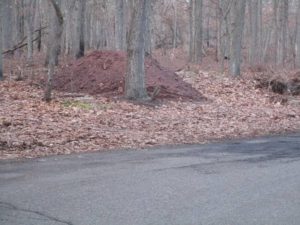
An illegally dumped pile of fill dirt, apparently Piedmont soil dumped in the Coastal Plain of the Pine Barrens around Helmetta, Middlesex County.
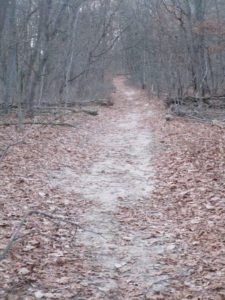
A Jamesburg Park Conservation Area trail of native white, sandy Pine Barrens soil near the dumped load of fill.
SNOW GEESE: I have not noticed any snow geese, “Chen caerulescens,” down from the Arctic. Bob Eriksen, a retired state Division of Fish and Wildlife biologist, checked in from just outside the Midlands in Warren County, saying, “Snow geese arrived, here, later than usual. Huge flocks came in overnight last Wednesday into Thursday morning December 13-14.”
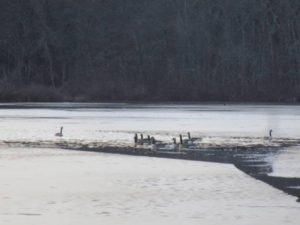
Canada geese, “Branta Canadensis,” on Helmetta Pond, Middlesex County.
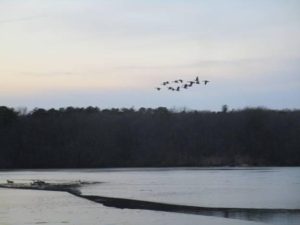
CANADA GEESE: I still stop to look at honking Canada geese, “Branta Canadensis,” in flight. And I get a bigger kick, perhaps, watching them land. While at Helmetta Pond, I noticed geese coming into the lake from the west, then swinging wide to the north and circling in for their landing. What a sight!
WINTER SOLSTICE: With the passing of the Winter Solstice on Thursday, December 21, daylight is increasing.
SNOWFALL TO DATE: To date, 8.0 inches at the Jamesburg-Helmetta area of Middlesex County. In this area, specifically New Brunswick, Middlesex County, the average seasonal total is 25.8 inches.
WEATHER: National Weather Service forecasting, along with other information, for the Jersey Midlands is at http://www.weather.gov/phi/.
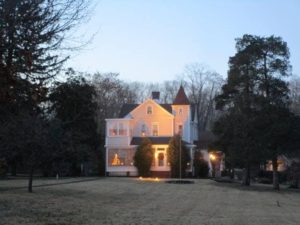
Merry Christmas from Helmetta. Here, the old Clemons house, one of the mansions associated in the 20th Century with the George W. Helme Snuff Mill — in this case, belonging to one of the mill’s upper level managers. According to house owner Carol Bohinski, “The Clemons mansion was built in 1890 by Arthur Clemons, brother-in-law to George W. Helme. Helme’s grandson, Arthur Helme Clemons, was a Helme Company President.”
Joe Sapia, 61, is a lifelong resident of Monroe — in South Middlesex County, where his maternal family settled more than 100 years ago. He is a Pine Barrens naturalist and a gardener of organic vegetables and fruit, along with zinnias and roses. He draws inspiration on the Pine Barrens around Helmetta from his mother, Sophie Onda Sapia, who lived her whole life in these Pines, and his Polish-immigrant grandmother, Annie Poznanski Onda. He gardens the same backyard plot as did his Grandma Annie and Italian-American father, Joe Sr. Both are inspirations for his food gardening. Ma inspires his rose gardening. Joe is a semi-retired print journalist of almost 40 years. His work also is at @JosephSapia on Twitter.com, along with Facebook.com on the Jersey Midlands page.
Copyright 2017 by Joseph Sapia
Article and photos by Joe Sapia
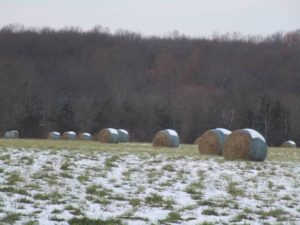
Fall meets winter with rolls of hay awaiting harvest on snow-covered farmland on the Princeton Ridge in Hopewell Township, Mercer County. The Princeton Ridge is one of three well-known pieces of hilly ground just north of downtown Princeton, the other two being Sourland Mountain and the Kingston Ridge.
SEASON’S FIRST SNOWFALL: My house in Monroe, Middlesex County, got its first snowfall of the season, this week – actually three snowfalls! The individual totals were December 9-10, Saturday-Sunday, 5.0 inches; December 13-14, Wednesday-Thursday, 1.5 inches; and December 15, Friday, 1.5 inches. All told, 8.0 inches. In my area, specifically New Brunswick, the average seasonal total is 25.8 inches.
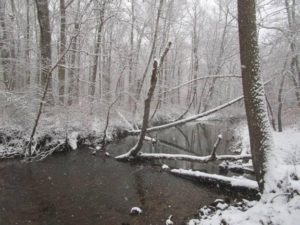 Snow falls along Manalapan Brook in Monroe, Middlesex County, during the season’s first snowfall, December 9-10, Saturday-Sunday. This locale is only a few hundred feet from my front door and I remember walking to this part of “The Brook” with my father when I was about 4-years-old, or more than 55 years ago.
Snow falls along Manalapan Brook in Monroe, Middlesex County, during the season’s first snowfall, December 9-10, Saturday-Sunday. This locale is only a few hundred feet from my front door and I remember walking to this part of “The Brook” with my father when I was about 4-years-old, or more than 55 years ago.
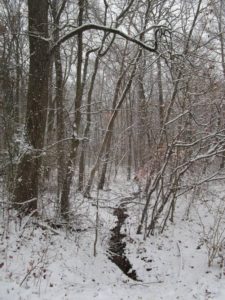
A stream cuts its way through the Manalapan Brook floodplain in Monroe, Middlesex County, during the first snowfall, December 9-10, Saturday-Sunday. This locale, at the bottom of my street, is what I have always known as “The Swamp.”
SNOWFENCING: As we travel through the Jersey Midlands, we may see snow-fencing in place to prevent drifting across roadways. The idea is to get the fencing up before it snows and hope it does not snow after farmers need to get in their fields for spring plowing or, that is, before it ends snowing for the season.
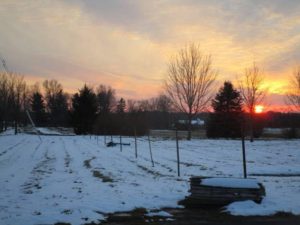
In Hopewell Township, Mercer County, this snow-fence was not up in time for the December 9-10, Saturday-Sunday, snowfall. Stakes in place, yes. Actual fencing, no.
GEMINID METEOR SHOWER: The Geminid Meteor Shower on the Wednesday-Thursday, December 13-14, overnight was a washout for me because of cloudy skies. More disappointing, because during that overnight, I was driving home from Baltimore and was hoping to be entertained for 2-1/2 to 3 hours. But that was a snowy night, so the viewing was not to be. Did anybody get lucky and see meterors?
‘SNOWBIRDS’ IN THE GARAGE: As I work in the yard or go between my house and my Jeep, I often leave the garage doors open. Occasionally over the years, I find a bird in the garage – seemingly always a “snowbird,” or dark-eyed junco, “Junco hyemalis,” birds that travel from as far away as Canada to stay from fall to spring. Most recently, I found one in the garage this week. Why seemingly always a snowbird in the garage? I do not know. Any thoughts?

A snowbird sits on top of my backyard birdfeeder while snow falls Friday, December 15, in Monroe, Middlesex County. American holly, “Ilex opaca,” is in the foreground.
AROUND THE BACKYARD: I sitting at my desk, in a corner room with windows facing north from the side of the house and facing west into the backyard, when I heard a wheezing call. A hawk? I looked into the backyard and saw no birds around the feeder or elsewhere in the backyard. However, I did notice a squirrel, “Sciurus carolinensis,” on the pole holding the feeder. The squirrel was frozen in place, facing downward, or in fleeing position. Yes, I thought, that probably was a hawk I heard. When the predator is around, the lucky prey flees.
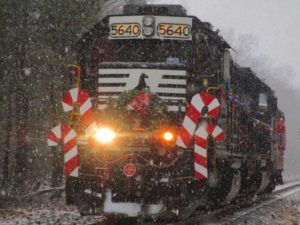
The annual ConRail Santa Train rumbled through Monroe, Middlesex County, this time while it is snowing December 9, Saturday. The Santa Train is especially fulfilling to me because it is a tradition of about 35 years; passes on railroad tracks my family has lived along for more than 100 years, as close as bordering the property and as far as my house, a quarter-mile; and, I have loved the freights on this line since my childhood days of the mighty Pennsylvania Railroad. It passes on the former line of the Camden-Amboy Railroad, the first railroad in the country, in the early 1830s, to replace equine power with mechanical power.
VOICES FROM AFIELD, CHRISTINE DENNELER: Christine Denneler, one of my Pine Barrens mentors over the last 35 years, checked in, regarding hunting: “Since most of my husband’s family is gone, hunting is not talked about at the holiday table as it was in the old days. (Late husband) Bill was not an avid hunter as was his grandpop, but he and his father liked the camaraderie.” (Chris has been a backbone of hiking in the Outdoor Club of South Jersey, www.ocsj.org, for decades. To go on a Chris Denneler hike is to learn the Pine Barrens.)
TONY’S FARM AND GARDEN CENTER: I was driving home from South Jersey and took advantage of passing Tony’s Farm and Garden Center — started and run by the Ciaccio family in Robbinsville, Mercer County, since 1946 — by stopping in. I have been patronizing Tony’s – in my case, for houseplants, vegetable plants, and garden supplies – for decades. It is one of my favorite places in the Jersey Midlands. Not only was it holding on to the 2017 gardening season, but it was decked out for Christmas. So, I bought a Christmas cactus – my first shot at one, so let us see if I can keep it alive – and two devil’s ivy houseplants – which even I have a hard time killing. (A shout-out to Ciaccio family members, especially young Tony, for their quality products and service and friendliness. Tony’s is one of my main sources for gardening information.)

Wreaths at Tony’s Farm and Garden Center in Robbinsville, Mercer County.

Poinsettias at Tony’s Farm and Garden Center

Christmas cactuses at Tony’s Farm and Garden Center.
VOICES FROM AFIELD, PRISCILLA “PEPPY” BATH: Outdoorswoman Priscilla “Peppy” Bath checked in on hiking Jake’s Branch County Park in the Ocean County Pine Barrens: “I have never before been to the park and it is beautiful with many well-marked trails. We hiked the Blue (Trail) 4-mile hike. Alongside of the trail were many patches of trailing arbutus (“Epigaea repens”) and also turkey beard (“Xerophyllum asphodeloides”). Neither was in bloom, but I will go back in the spring and see the beautiful flowers.” More information on Jake’s Branch Park is available at http://www.oceancountyparks.org/ContentPage.aspx?ID=0694b294-986f-46e6-a679-d03ac775c176.
‘SNOW GEESE’: This time of year, we can expect to see snow geese, “Chen caerulescens,” down from the Arctic tundra – perhaps flying by, noticeable by their white color and black-tipped wings, or in farm fields. So far, I have not seen any, but hope to. (The species also has a dark version, or the “blue goose.”)
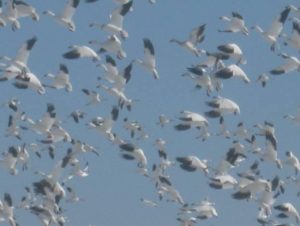
I took this photo of snow geese a few years ago on farmland along the Cranbury-Plainsboro boundary in Middlesex County. Here, their white bodies and black wingtips, which provide easy identification, are easily seen.
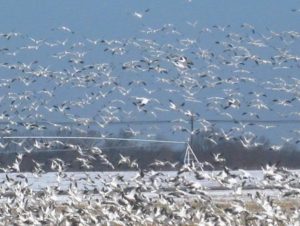
Another photograph of snow geese from a few years ago. Here, both in flight and in a cornfield.
TUNDRA SWANS: Tundra swans, “Cygnus buccinators” – New Jersey’s only native swan — are in the area. They, too, are cold-weather visitors from the Arctic tundra. My favorite place to see them is Whitesbog, in the main Pine Barrens and part of Brendan T. Byrne State Forest. Here is a story about Tundra Swan No. 207, spotted this season at Whitesbog, http://birdquiz.net/t207-2017/.
THE QUIET OF WINTER: In the winter, with many people staying inside in the warmth, the outdoors has a quiet solitude in many spots. Two places I visited during the week come to mind, the Delaware and Raritan Canal, where I visited the canal in Franklin Township, Somerset County, and the confluence of Crosswicks Creek and the Delaware River at Bordentown City, Burlington County.
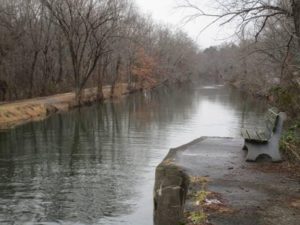
The Delaware and Raritan Canal at Griggstown in Franklin, Somerset County.

Crosswicks Creek at Bordentown City, Burlington County.
ATLANTIC OCEAN TEMPERATURES: The Atlantic Ocean temperature at Sandy Hook on December 17, Sunday, ranged from about 36 to 40 degrees.
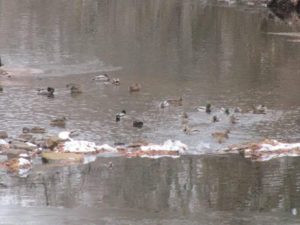
Mallard ducks, “Anas platyrhynchos,” on Cranbury Brook in Cranbury, Middlesex County.
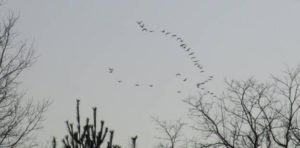
A familiar sound is the honking, then sighting, of Canada geese, “Branta Canadensis,” I captured this photograph from my backyard in Monroe, Middlesex County.
SUNRISE/SUNSET: For Sunday, December 17, to Saturday, December 23, the sun will rise about 7:15 to 7:20 a.m. and set about 4:25 p.m. For Sunday, December 24, to Saturday, December 30, the sun will rise about 7:20 a.m. and set about 4:35 to 4:40 p.m.
WINTER SOLSTICE: The Winter Solstice, or the day with the least amount of daylight, is December 21, Thursday. The sun rises about 7:17 a.m. and sets about 4:35 p.m. After, the amount of daylight grows until June 21, the “longest day” of the year.
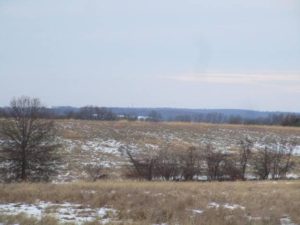
A view of Sourland Mountain, which is on the boundary of Somerset, Mercer, and Hunterdon counties, in the background across the farmland. This is as seen from the Princeton Ridge, Mercer County.
WEATHER: National Weather Service forecasting, along with other information, for the Jersey Midlands is at http://www.weather.gov/phi/.
UNEXPECTED WILDLIFE REFUGE SEEKS VOLUNTEERS: Our friends at the Unexpected Wildlife Refuge, just south of the Jersey Midlands in Gloucester County, seek volunteers to patrol the property to keep hunters off until at least the end of January. If interested, contact the refuge, http://unexpectedwildliferefuge.org/.
 Snow clings to an American holly, “Ilex opaca,” in my backyard in Monroe, Middlesex County, from the December 9-10, Saturday-Sunday. This was the first snowfall of the season at my house.
Snow clings to an American holly, “Ilex opaca,” in my backyard in Monroe, Middlesex County, from the December 9-10, Saturday-Sunday. This was the first snowfall of the season at my house.
Joe Sapia, 61, is a lifelong resident of Monroe — in South Middlesex County, where his maternal family settled more than 100 years ago. He is a Pine Barrens naturalist and a gardener of organic vegetables and fruit, along with zinnias and roses. He draws inspiration on the Pine Barrens around Helmetta from his mother, Sophie Onda Sapia, who lived her whole life in these Pines, and his Polish-immigrant grandmother, Annie Poznanski Onda. He gardens the same backyard plot as did his Grandma Annie and Italian-American father, Joe Sr. Both are inspirations for his food gardening. Ma inspires his rose gardening. Joe is a semi-retired print journalist of almost 40 years. His work also is at @JosephSapia on Twitter.com, along with Facebook.com on the Jersey Midlands page.
Copyright 2017 by Joseph Sapia
Article and photos by Joe Sapia
Note: The yard references are to my house in the section of Monroe between Helmetta and Jamesburg in South Middlesex County. My yard is in a Pine Barrens outlier on the Inner Coastal Plain, the soil is loamy, and my neighborhood is on the boundary of Gardening Zones 6b (cooler) and 7a (warmer). Notes and photographs are for the period covered, unless otherwise noted.
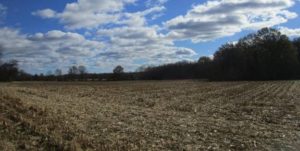
Farmers are harvesting field corn as fall turns into winter. Here, a cut-down cornfield in Monroe, Middlesex County. We have seen a wide fluctuation of temperatures this fall, from summer-like to winter-like, but look out for long days of cold, perhaps accompanied by snow.
FARMING: Look for the traditional farming season to wrap up. Farmers are continuing to harvest field corn, for example. Meanwhile, we are transitioning into the winter holidays season at Christmas tree farms.
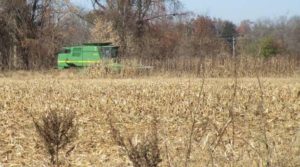
A farmer works a corn field outside Neshanic Station, Somerset County.
CHRISTMAS TREE FARMS: For those seeking trees from local farms, whether recent cuts or cut-your-own, here is the New Jersey Christmas Tree Growers Association website’s farm locater, https://njchristmastrees.net/find-a-farm/. Keep in mind, all Christmas tree farms may not be listed. (I heard an interesting radio news report regarding Christmas trees in America. The report said we are facing the effects of the recession 10 years ago – that is, with the recession, farmers planted less trees and with those trees now reaching cutting time, there are less trees. In turn, higher prices. The report said this will go on for years.)
DEER RUT: While I have not noticed any bucks roaming lately — because, I suspect, the mating season, or rut, of deer, “Odocoileus virginianus,” is peaking and bucks and receptive does are holed up in the seclusion of woods — I did come across a dead buck on farmland in Monroe, Middlesex County. It was a fresh kill and near a busy road, so he probably was a victim of a motor vehicle accident. Additionally, he was probably sex-crazed and less wary, crossed the road, and got hit. I noticed the dead buck because nature was taking its course and vultures were feasting upon him. Definitely turkey vulture, “Cathartes aura”; Maybe black vulture, “Coragyps atratus,” too.
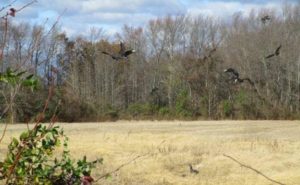
I spooked these vultures when I stopped to photograph them on a deer carcass in Monroe, Middlesex County. Notice the dead buck on the middle-to-right bottom of the photograph.
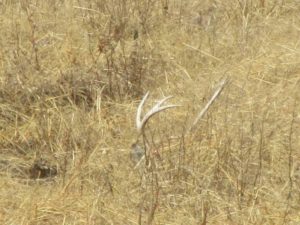
The dead buck appeared to be a pretty good size.
DEER HUNTING: Various deer-hunting seasons have been underway and will continue into 2018, with “Deer Week,” or the Six-Day Shotgun Season, being Monday, December 4, to Saturday, December 9. (If you are traveling through the Pine Barrens, take note of those primitive buildings that are quiet for 51 weeks of the year. During Deer Week, they will be hopping.) Anyway, be careful if heading into the woods during deer seasons. One, it might be advisable to stay out of the woods. Two, if you are in the woods, at least wear blaze orange. Three, during Deer Week, just stay out of the woods unless you are hunting. A year or so ago, I walked underneath a bowhunter in a deer-stand, never seeing him until he spoke to me from above. Fortunately, I wore blaze orange and was obvious to him. This rattled me into thinking I am not as aware of my woods surroundings as I should be.
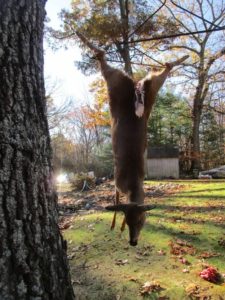
This doe was killed in the Route 33 area of Manalapan, Monmouth County.
FALL FOLIAGE: The Jersey Midlands are past the peak of the changing colors of fall, but there were some beautiful brown/Earth-tone views.

Fall foliage and a cloudy sky at Westminster Cemetery in Cranbury, Middlesex County.

A sunny day upon the fall foliage along Manalapan Brook in Monroe, Middlesex County.
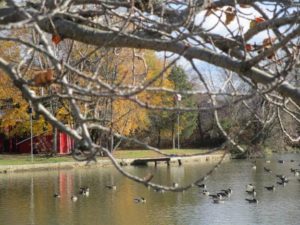
“Englishtown Lake” (properly Lake Weamaconk) in Monmouth County. The lake is formed by the damming of Weamaconk Creek, part of the Raritan River-Bay watershed.
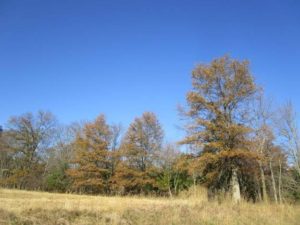
Farmland below Sourland Mountain in Montgomery, Somerset County.
SOURLAND MOUNTAIN: This week, I had to go to Hillsborough, Somerset County, to attend a funeral service. Because I was nearby, I took a ride to Sourland Mountain on the boundary of Somerset, Hunterdon, and Mercer counties. Sourland Mountain, also known as Neshanic Mountain and Zion Mountain, sits on the Piedmont geological area. It runs about 10.5 miles by 4.5 miles and rises about 570 feet above sea level, with its surrounding lowlands as low as about 90 feet above sea level.
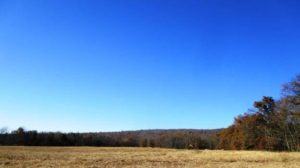
Looking across farmland at Sourland Mountain at Montgomery, Somerset County.
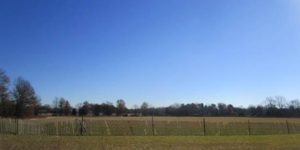
Fencing to hold back snow drifting on roads at Montgomery, Somerset County.
RARITAN RIVER SOUTH BRANCH: The South Branch of the Raritan River is 51 miles long, draining 276 square miles in Somerset, Hunterdon, and Morris counties. It meets the North Branch north of Neshanic Station, forming the main stem of the Raritan River.
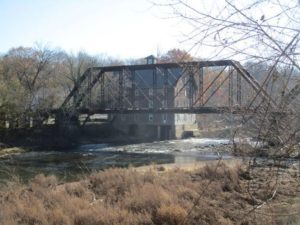
An old railroad bridge and mill on the South Branch of the Raritan River at Neshanic Station.
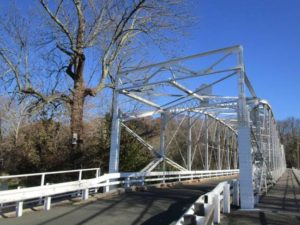
The one-lane, 1896 iron bridge over the South Branch of the Raritan River, connecting Branchburg and Hillsborough at Neshanic Station, Somerset County.
VOICES FROM AFIELD, EAGLES: Michael Franken checked in regarding bald eagles, “Haliaeetus leucocephalus.” He reported seeing them on the boundary of Cranbury and Plainsboro, Middlesex County, Thanksgiving Day and Black Friday. In New Jersey, the bald eagle is “endangered,” or in immediate peril, as a breeder and “threatened,” or if conditions continue or begin to deteriorate, they will advance to endangered, in general. The state Division of Fish and Wildlife bald eagle page is http://www.state.nj.us/dep/fgw/ensp/pdf/end-thrtened/baldeagle.pdf.
DRIVE-BY NATURALIST, BIRD OF PREY: I was driving through a farming area of South Brunswick, Middlesex County, and came across a bird of prey perched in a tree. I could not get a good look or a good photograph of the bird. Later, in looking at the photo on my computer, the bird’s head appeared to be somewhat, perhaps not that blatantly, lighter than the body. A bald eagle, “Haliaeetus leucocephalus,” transitioning from juvenile to adult?
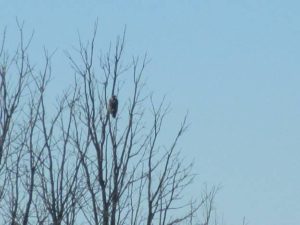
A bald eagle, “Haliaeetus leucocephalus,” transitioning from juvenile to adult?
FULL MOON: The upcoming full moon — the Full Long Night Moon on the December 3-4, Sunday-Monday overnight — will be 2017’s only full “super moon,” that is, when the full moon comes close to the Earth, or 222,443 miles away. The closest will be at 4 a.m. Monday, December 4, when the moon will appear “about 7 percent larger and 16 percent brighter than usual,” according to the National Geographic.

Around 5 p.m. November 20, Monday, or a short time after sunset, there was a beautiful rainbow-shaped and -colored cloud in the western sky. The color was caused by the reddish sunlight from under the horizon hitting the cloud. And more toward the southwest was the crescent moon. What a view! (The photos, all shot from my yard, from where I have watched the night sky since the American-Soviet “Space Race”: the moon, stars, planets, meteorites, and the International Space Station.)
DARK SKIES: As you probably can tell, I am a big fan of a dark sky, to be able to see the stars, planets, satellites clearly. When I remodeled my house over the summer, I insisted on shielded outside lighting, which directs my three outside lights downward, not horizontally or upward. (At night, a shielded light will emit a cone of light, while an unshielded light emits a blinding burst of light. Also, red and green lights protect night vision.) On Saturday, November 25, I heard this story on NPR, about a proposal for part of Idaho to get recognized by the International Dark-Sky Association as a “dark sky reserve,” https://www.npr.org/2017/11/25/566074921/idaho-dims-the-lights-for-one-of-the-best-night-skies-anywhere. Go, Idaho! (I plan to be in Idaho for a wedding in August and hope to see that Idaho dark sky. Give people a wonderful view – turn off lights that project into the sky!)
AROUND PEDDIE LAKE: There were some nice views at Peddie Lake at Hightstown, Mercer County. The lake is about 15 acres, created by the damming of Rocky Brook, part of the Raritan River-Bay watershed. The Peddie School, a preparatory school, sits along the lake.
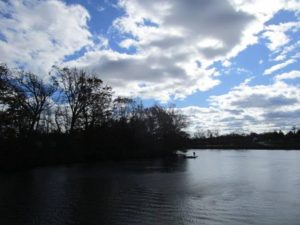
A fisherman on Peddie Lake under a partly cloudy sky.
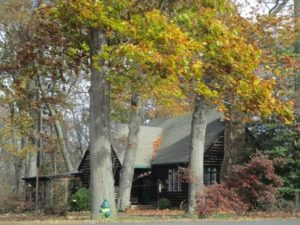
The Peddie Lake cabin.
PROTECTING THE JERSEY MIDLANDS: The Jersey Midlands are an incredible environmental resource: the Atlantic Ocean and other coastal waters, the Outer and Inner Coastal Plains, the Piedmont, the Pine Barrens, the Delaware River, valuable farmland. This alone is evidence of why we should protect the Midlands environment. But, more so, the area is under intense development pressure and stress because of its location at the New York City and Philadelphia metropolitan areas.
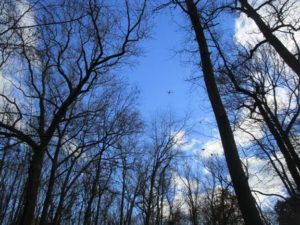
Despite the beauty here of the blue sky above the Manalapan Brook floodplain in Monroe, Middlesex County, notice the commercial jet in the sky, probably headed for Newark Airport. The Midlands are under intense stress because of they are part of both the New York City and Philadelphia metropolitan areas.
OCEAN TEMPERATURE: The Atlantic Ocean temperature at Sandy Hook was about 47 degrees over the November 25-26, Saturday-Sunday, weekend.
SUNRISE/SUNSET: For November 26, Sunday, to December 2, Saturday, the sun will rise about 6:55 to 7:05 a.m. and set about 4:30 to 4:35 p.m. For Sunday, December 3, to Saturday, December 9, the sun will rise about 7:05 to 7:10 a.m. and set about 4:30 p.m.WEATHER: The National Weather Service forecasting station for the area is at http://www.weather.gov/phi/.
CLOUDS: This week’s cloud photographs were captured at Monroe and Jamesburg, Middlesex County.

“Jamesburg Lake” (properly Lake Manalapan), looking from Monroe toward Jamesburg, Middlesex County.
IN THE GARDEN AND YARD: I try to get the yardwork done by Thanksgiving weekend. So far, the lawn has been cut for the last time, shrubs have been spruced up in the front yard, the gutters and drainpipes have been cleaned in the front of the house, the crawlspace where a two-room addition was put on the house circa 1967 has been secured, and the garage door and front cellar window well has been cleaned. Still to go, sprucing the backyard shrubs, cleaning the rear gutters and drainpipes, raking leaves into the garden, and, perhaps, roto-tilling the garden. I will not get the outside painting I had planned done. As the outside work ends, I have a ton of stuff to do inside over the winter.
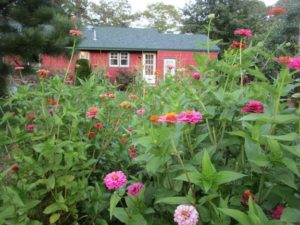
The garden in my backyard in August.
 This week in the garden.
This week in the garden.
UNEXPECTED WILDLIFE REFUGE: A little south of the Jersey Midlands, in Atlantic County, are our friends at the Unexpected Wildlife Refuge. Veronica Van Hof, the director, is seeking help in meeting a challenge. “As another way of supporting the Refuge, we have been accepted to be part of the Newman’s Own Foundation $500,000 Holiday Challenge, administered through CrowdRise,” Veronica said. “Every donation (‘voting’) through our page at CrowdRise increases the chance of our receiving additional funding through one of the Challenge prizes which range from $2,500 for 10th place up to $150,000 for first place.” The challenge runs to January 3. The challenge is at https://www.crowdrise.com/o/en/campaign/unexpected-wildlife-refuge-inc/unexpected-wildlife-refuge. More about Unexpected is at http://www.unexpectedwildliferefuge.org.
UPCOMING:
December 3, Sunday, 10 a.m. to 1 p.m. – Green Brook Cleanup at the Green Brook Regional Center, 275 Greenbrook Road, Green Brook, Somerset County, with the Lower Raritan Watershed Partnership and the Central Jersey Stream Team. More information at hfenyk@lowerraritanwatershed.org.
December 8, Friday, 2 p.m. to 3:30 p.m., Middletown, Monmouth County – “Forest Therapy” Walk, hosted by the Monmouth Conservation Foundation. “It is not intended to be a strenuous hike, but a time for mindful awareness in nature,” according to the foundation. More information, abrockwell@monmouthconservation.org.
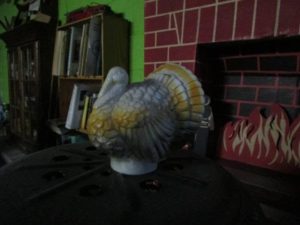
This turkey survived Thanksgiving. (Compliments of the eclectic Joey Archives: A plastic turkey from my 1960s youth, pictured in the faux cabin section of my basement.)
Joe Sapia, 60, is a lifelong resident of Monroe — in South Middlesex County, where his maternal family settled more than 100 years ago. He is a Pine Barrens naturalist and a gardener of organic vegetables and fruit, along with zinnias and roses. He draws inspiration on the Pine Barrens around Helmetta from his mother, Sophie Onda Sapia, who lived her whole life in these Pines, and his Polish-immigrant grandmother, Annie Poznanski Onda. He gardens the same backyard plot as did his Grandma Annie and Italian-American father, Joe Sr. Both are inspirations for his food gardening. Ma inspires his rose gardening. Joe is a semi-retired print journalist of almost 40 years. His work also is at @JosephSapia on Twitter.com, along with Facebook.com on the Jersey Midlands page.
Article and photos by Joe Sapia
Note: The yard references are to my house in the section of Monroe between Helmetta and Jamesburg in South Middlesex County. My yard is in a Pine Barrens outlier on the Inner Coastal Plain, the soil is loamy, and my neighborhood is on the boundary of Gardening Zones 6b (cooler) and 7a (warmer). Notes and photographs are for the period covered, unless otherwise noted.

Looking upstream on the Delaware River at dusk from the historic iron bridge connecting Stockton, Hunterdon County, New Jersey, to Centre Bridge, Bucks County, Pennsylvania. The photograph was taken from the New Jersey side, looking toward Pennsylvania. The bridge was built in 1926 and refurbished in 2007. This section of the Delaware River is part of the National and Wild Scenic River System.
DELAWARE RIVER: After the Pine Barrens, the Delaware River is my favorite local ecosystem. I especially love the part of the river north of Trenton. There, an approximately 150-mile stretch of the river, from Washington Crossing at Mercer County, New Jersey, and Bucks County, Pennsylvania, north to Hancock, New York, is part of the National and Wild Scenic River System. Aside from what the System name suggests, eligibility for the System requires the river have protection in place and be free-flowing. At 330 miles, the Delaware River is the longest free-flowing river, meaning it is uninterrupted by a dam, east of the Mississippi River. Next summer, consider tubing the Delaware. Meanwhile, these two books can keep you company, “Natural Lives, Modern Times – People and Places of the Delaware River” by Bruce Stutz and “The Illustrated Delaware River – the History of a Great American River” by Hal Taylor.

Looking downstream on the Delaware River from the Centre Bridge-Stocton bridge. New Jersey is to the left, Pennsylvania to the right. This section is part of the National and Wild Scenic River System.
HOUSE SPARROWS: I watch many a bird perched in the shrubs outside my living room window at Monroe, Middlesex County. This week, I noticed a small bird of chestnut, black, and gray – a house sparrow, “Passer domesticus.” Beautiful! Alas, it is non-native, a species from Eurasia and North Africa introduced to North America in New York in 1851, according to the National Audubon Society. “Many people regard house sparrows as undesirables in their yards, since they aren’t native and can be a menace to native species,” according to Cornell University’s All About Birds website. “House Sparrows are so closely entwined with people’s lives that you probably will find them around your home even without feeding them.” (A shout out to two New Jersey Audubon Society naturalists for heading me in the proper direction in identifying this bird: Pete Bacinski, retired, and Scott Barnes, active. I am a pretty bad birder, so I appreciate the help.)
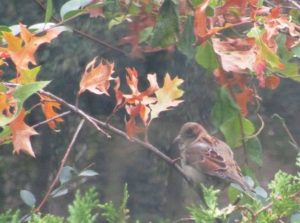
A house sparrow in the front yard of my house in Monroe, Middlesex County.
CANADA GEESE: Speaking of beautiful but pain-in-neck birds, I observed Canada geese in different locales during the week. I have a funny relationship with Canada geese, “Branta canadensis,” finding them to be admirable parents and elegant when personally connecting with them, while in a standoffish way viewing them as pooping, polluting pests. This week, I leaned in a positive direction. (If you get a chance, observe Canada geese as a couple. “They mate for life with very low ‘divorce rates,’ and pairs remain together throughout the year,” according to Cornell University’s All About Birds website. Also, they care for their young as very protective parents. Perhaps a lesson for humans, “Homo sapiens.”)
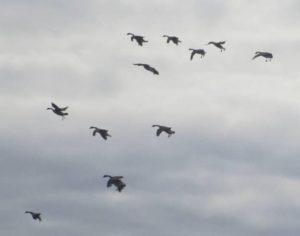
Canada geese landing at a retention pond near Route 33 in Monroe, Middlesex County.
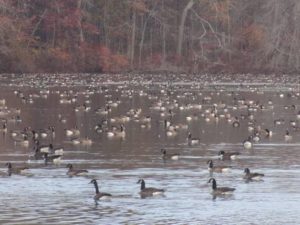
Canada geese dot ETRA Lake in East Windsor, Mercer County.
VOICES FROM AFIELD, No. 1, WILL SIGLE: Fellow Monroe, Middlesex County, resident Will Sigle, a retired science teacher, checked in with some thoughts on farming and wildlife. One of the things Will mentioned was about his yard, “Last year, I had a red-tail (hawk, ‘Buteo jamaicensis’) dining on a daily basis. Amazing how quiet the yard was when he was around.” Ah, yes, when a raptor is around, smaller birds know to beware.
BIRDING NOTES: While in my house in Monroe, Middlesex County, one night this week, I heard a great horned owl, “Bubo virginianus,” hooting. This species is an early breeder, so I am figuring it was either a territorial call or a call for a mate. I went outside to get a better idea where it was calling from, but it had stopped by the time I got outside. Keep your ears open for this resonating baritone. Years ago, one must have landed in a tree near my bedroom in the Monroe farmhouse I was living in at the time and started calling – Man, did I come alive in surprise when I first heard it.

A pumpkin patch at the Fresh Ponds section of South Brunswick, Middlesex County.
DEER RUT: One night, this week, I heard a familiar rustle in the fallen leaves of my neighborhood. I waited and, yes, a doe and her two young walked through a neighbor’s yard and onto my street. Hiding in bushes in my front yard, I watched them for maybe 10 or 15 minutes, only 125 feet or less away. They were jumpy, but they never fled. Finally, I lost sight of them up the street. This week, I saw no bucks, as I had been seeing in recent weeks. So, I suspect the mating season, or rut, of deer, “Odocoileus virginianus,” is at its peak – with bucks and receptive does holed up in secluded spots in the woods.
THE ENIVIROMENTALISM OF DEER HUNTING: “U.S.1” newspaper recently had an interesting article on how deer-hunting is now environmentally in vogue, at least in some circles such as in the Hopewell Valley area on the boundary of Mercer, Somerset, and Hunterdon counties. When this was mentioned here recently, it generated quite a bit of pro-hunting chatter. The recent “U.S.1” article, http://princetoninfo.com/index.php/component/us1more/?Itemid=6&key=11-8cover.
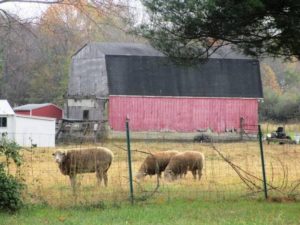
Sheep at a farm in Monroe, Middlesex County.
FIRE IN THE PINES: The state Pinelands Commission is considering fire-break permits in the Pine Barrens area it covers – basically from the Route 528/Cassville section of Jackson, Ocean County, and south. The Pine Barrens are susceptible to wildfire because of their well-drained, sandy soil with dry, dense, and highly flammable vegetation. Fire-breaks can stop fires or at least hopefully slow their threat.
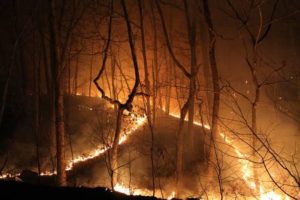
Helmetta’s Joey Slezak took this photograph of a state Forest Fire Service control-burn a few years ago in the Pine Barrens around Helmetta. The Pine Barrens around Helmetta are not part of the state-regulated “Pinelands.” (Photo copyrighted by Joey Slezak).
VOICES FROM AFIELD, NO. 2, VERONICA VAN HOF: Veronica Van Hof, director of the Unexpected Wildlife Refuge a bit south of the Midlands in Buena Vista, Atlantic County, checked in, regarding how spring peeper treefrogs, “Pseudacris crucifer,” normally early spring callers, have been heard in recent weeks: “We heard peepers recently, too! I was surprised but they’re so unmistakable.” Veronica also noted the arrival of winter visitors, bufflehead ducks, “Bucephala albeola,” down from Canada, “Just got our first buffleheads today” — Sunday, November 12 – “a pair lazily dabbling around the pond.”
DAIRY FARMS: In recent years, there has been a resurgence in dairying (at a scaled-down level) and home delivery of dairy products. But in my youth in the 1960s, local commercial dairy farms, along with home delivery, were a way of life – in my case, Forsgate Farms of Monroe, Middlesex County, at my Monroe home and Decker’s Dairy of Hightstown-East Windsor, Mercer County, at my elementary school, St. Mary School in South River, Middlesex County. The Hightstown-East Windsor area also had Conover’s Dairy. Conover’s Dairy, for example, closed in 1972, according to the East Windsor township website. (See https://www.east-windsor.nj.us/conovers-dairy.)

A Conover’s Dairy and Decker’s Dairy display at the Hightstown Diner in Mercer County.
PERRINEVILLE LAKE PARK: New Jersey’s Coastal Plain, as its name suggests, is generally flat. But at Perrineville Lake Park in Millstone and Roosevelt, both in Monmouth County, the land is hilly, thanks to the cuesta geological formation. This hilly formation generally runs from Sandy Hook in Monmouth County to the Philadelphia area, dividing the sandy soil Outer Coastal Plain and the generally dark soil Inner Coastal Plain. The park is about 1,200 acres and includes the lake, formed by the damming of Rocky Brook, woods, and field. More on the park, http://monmouthcountyparks.com/documents/130/PerrinevilleForWeb.pdf and https://www.monmouthcountyparks.com/page.aspx?Id=2550.
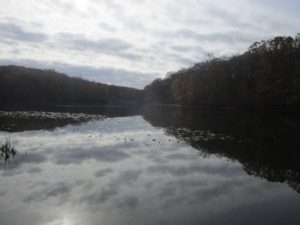
Perrineville Lake in Millstone, Monmouth County.
DELAWARE AND RARITAN CANAL: The Delaware and Raritan Canal’s main shipping channel ran about 30 miles between the areas of New Brunswick, Middlesex County, and Trenton, Mercer County. Another canal, the feeder canal, replenished the main canal with water from the Delaware River. The feeder canal also ran about 30 miles between the areas of Frenchtown, Hunterdon County, and Trenton. The feeder canal later was used for shipping, too. The canal operated for about 100 years from the 1830s to the 1930s. Today, the canal provides easy hiking, bicycling, boating, and fishing along both main and feeder canals. More information, http://www.dandrcanal.com.
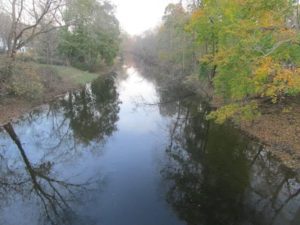
Looking south on the Delaware and Raritan Canal’s feeder at Stockton, Hunterdon County.
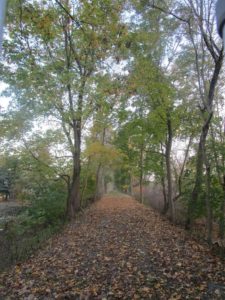
The Delaware and Raritan Canal, here the feeder canal, towpath at Stockton, Hunterdon County.
OCEAN TEMPERATURES: The Atlantic Ocean temperature at Sandy Hook was about 49 degrees over Friday-Saturday, November 17-18.
SUNRISE/SUNSET: For November 19, Sunday, to November 25, Saturday, the sun will rise about 6:50 to 6:55 a.m. and set about 4:35 p.m. For November 26, Sunday, to December 2, Saturday, the sun will rise about 6:55 to 7:05 a.m. and set about 4:30 to 4:35 p.m.
WEATHER: The National Weather Service forecasting station for the area is at http://www.weather.gov/phi/.
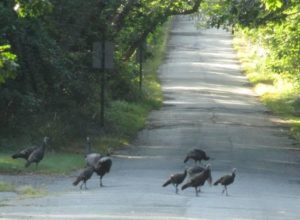
Happy Turkey Day – Thanksgiving, Thursday, November 23. In the photograph, wild turkeys, “Meleagris gallopavo,” cross a road in the Pine Barrens around Helmetta in 2015.
Joe Sapia, 60, is a lifelong resident of Monroe — in South Middlesex County, where his maternal family settled more than 100 years ago. He is a Pine Barrens naturalist and a gardener of organic vegetables and fruit, along with zinnias and roses. He draws inspiration on the Pine Barrens around Helmetta from his mother, Sophie Onda Sapia, who lived her whole life in these Pines, and his Polish-immigrant grandmother, Annie Poznanski Onda. He gardens the same backyard plot as did his Grandma Annie and Italian-American father, Joe Sr. Both are inspirations for his food gardening. Ma inspires his rose gardening. Joe is a semi-retired print journalist of almost 40 years. His work also is at @JosephSapia on Twitter.com, along with Facebook.com on the Jersey Midlands page.
Article and photos by Joe Sapia
Note: The yard references are to my house in the section of Monroe between Helmetta and Jamesburg in South Middlesex County. My yard is in a Pine Barrens outlier on the Inner Coastal Plain, the soil is loamy, and my neighborhood is on the boundary of Gardening Zones 6b (cooler) and 7a (warmer). Notes and photographs are for the period covered, unless otherwise noted.
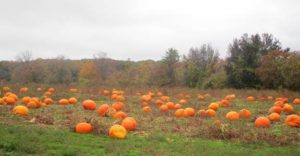
Pumpkins and fall foliage, both taking a last stand for the season, at the Red Wagon Farm Market on Route 33 and Smithburg Road/Route 527-A in Manalapan, Monmouth County.
SNOWBIRDS: I saw the first “snowbirds,” or dark-eyed juncos, “Junco hyemalis,” of the season on Tuesday, November 7, Election Day, around sunrise at St. James Cemetery in Monroe, Middlesex County. The birds are easy to identify by their gray tops and white undersides – “gray skies above, snow below” – and the white edges of their splayed tails as they take off. My rule of thumb is to look for these birds around Halloween, October 31, arriving for the cold weather from as close as the high ground of North Jersey or Pennsylvania and as far away as Canada. Around my yard, I look for these small birds on the ground under the bird-feeder or in bushes. I will see them around my yard to about mid- to late April.
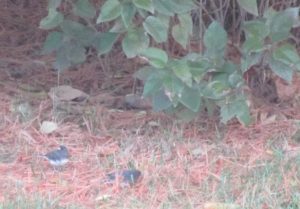
I saw the first “snowbirds,” or dark-eyed juncos, of the season Tuesday, November 7, Election Day, at St. James Cemetery in Monroe, Middlesex County. These birds arrive from the north for the cold-weather season.
VOICES FROM AFIELD, MORE WINTER BIRDS: Diane Larson, a long-time gardening mentor, checked in on the afield side, regarding Beaver Dam Creek in Brick, Ocean County. “Another bird sign of winter – the buffleheads (“Bucephala albeola’’) and mergansers (genus “Mergus”) arrived in Beaver Dam Creek right on schedule – saw them Saturday (November 4) for the first time. We also have otters (“Lutra Canadensis”). They are very elusive, but we’ve seen them and heard them splashing in the water around 8:00 p.m. one night (during) the last week of October. We went outside and tried to see them, but they swam away. All we saw was their wake and heard their grunts.”
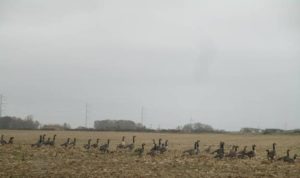
Canada geese, “Branta canadensis,” on the Skeba Farm in the Applegarth section of Monroe, Middlesex County.
BIRDS IN MY YARD: As I was doing yardwork, birds were feasting on corn hearts at my backyard bird-feeder: dark-eyed junco, “Junco hyemalis”; mourning dove, “Zenaida macroura”; tufted titmouse, “Baeolophus bicolor”; and Carolina chickadee, “Poecile carolinensis.”
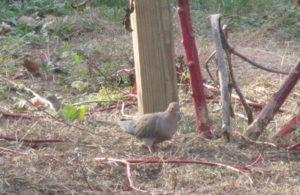
A Mourning Dove at my Backyard Bird-feeder

A Tufted Titmouse at my Backyard Bird-Feeder
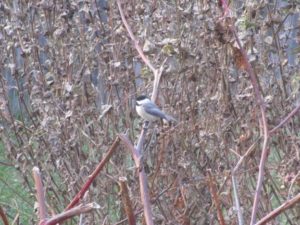
A Chickadee at my Backyard Feeder
GARDEN AND YARD: As I cut the lawn, hopefully for the last time of the year, I smelled wild onions I had mowed down. A bittersweet scent – one pointing back at the year’s peak of vegetable growing, one pointing to a gardening season that lingers. The Jamesburg-to-New Brunswick area of Middlesex County got down to about 20 degrees on the Friday-Saturday, November 10-11, overnight, pretty much bringing an end to the warm weather gardening season. However, I did find a few cherry tomatoes in my garden. (I have a cool weather crop of carrots planted. So, I am hoping for some kind of harvest.) So, this week, I cut the lawn, dumped my last barrel of gardening water, and mowed down the garden, except for the carrots. As for the yard work, I try to get that all done by Thanksgiving.
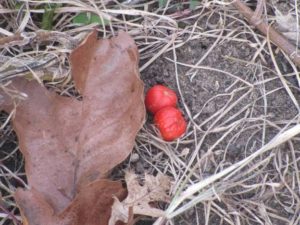
I found these cherry tomatoes in my garden. The top one was in good condition and I popped it into my mouth right in the yard and ate it.
VOICES FROM AFIELD, NO. 2, LINGERING SPRING: Last week, I mentioned I thought I heard the call of a spring peeper treefrog, “Pseudacris crucifer,” at Farrington Lake on the boundary of South Brunswick, East Brunswick, and North Brunswick in Middlesex County. They are normally early spring callers. Jean Montgomerie, an environmental scientist who lives in Freehold and works in the Pine Barrens, said, “Those were spring peepers; I heard them last week too.” Spring, in the form of fall, is playing itself out again, this year.
NIGHT SKY: With the cold spell at the end of the week, I stood in my yard between about 10:30 p.m. and 11:30 p.m. and looked at the night sky. With the temperature at about 23 degrees and very little moisture in the air (with a dewpoint of about 8 degrees), it was one of the clearest night skies I recall, with great views of Auriga (overhead/east); Pleiades, or Seven Sisters (overhead); Orion (southeast); the Great Square of Pegasus (southwest); Cassiopeia (northwest); and the North Star. Take advantage of cold, dry fall and winter overnights. Get a revolving star chart, turn off the outside lights, go outside and acclimate your eyesight to the darkness, and look into the night sky.
THE MOON: The moon is waning from the Full Frost Moon of the November 3-4 overnight. The next full moon is the Long Night Moon on the December 2-3 overnight.

The morning moon, with the changing colors of the fall foliage underneath, at St. James Cemetery in Monroe, Middlesex County. The moon is waning from the Full Frost Moon of the November 3-4 overnight. The next full moon is the Long Night Moon on the December 2-3 overnight.
FALL FOLIAGE: The changing colors of fall foliage are all over the place – some past full color, some peaking, some yet to come. I take the colors as they come, rather than concentrating on a peak.
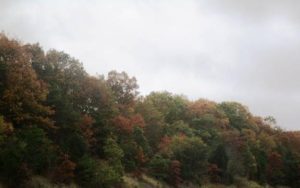
The changing colors of the fall foliage along Interstate 195 in Jackson, Ocean County.
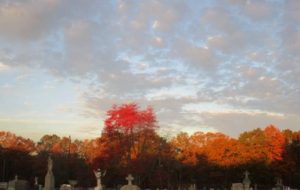
The rising sun’s light hits the top of the trees, lighting up the fall colors, at St. James Cemetery in Monroe, Middlesex County.
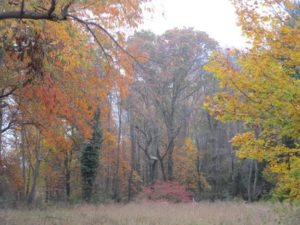
The changing colors between Davidson Mill Park and Pigeon Swamp in South Brunswick, Middlesex County.
DRIVE-BY NATURALIST, RED-TAILED HAWK: As I was returning home from my normal Sunday routine of lunch at the Hightstown Diner in Mercer County, I crossed the Millstone River on the boundary of Cranbury, Middlesex County, and East Windsor, Mercer County. On the Cranbury side, a large bird flew out of the trees, then low along the roadway – a red-tailed hawk, “Buteo jamaicensis.” I cranked off a shot on my camera. Not a good shot, but that is photojournalism – you take what you get, because the news does not necessarily stop for the journalist. The photo, at least, puts in perspective how low the bird was.
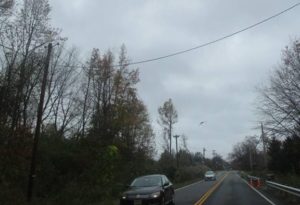
A red-tailed hawk flies low along a roadway on the boundary of Cranbury, Middlesex County, and East Windsor, Mercer County.
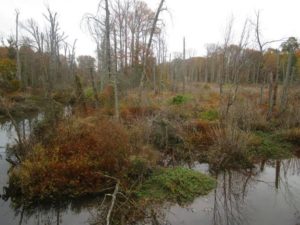
The Millstone River on the boundary of Cranbury, Middlesex County, and East Windsor, Mercer County.
VOICES FROM AFIELD, NO. 3, DEER RUT: I continue seeing normally hidden male deer, “Odocoileus virginianus,” because it is the mating season, or rut. This week, I saw one in southern Monroe, Middlesex County, at night. Then, as I was driving to work one morning in daylight, a deer bolted across a paved road in the Jamesburg Park Conservation Area in the Pine Barrens around Helmetta, Middlesex County. I did not get a good look at the deer, but, based on the way it bolted across the street and because I saw no others, my guess is it was a buck. Paul Migut checked in from South River, Middlesex County: “Spotted buck behind my firehouse. He’s been chasing two does around here.” Again, be careful driving during the rut, which should last until about mid-December.
CLOUDS: This week’s cloud shots are from St. James Cemetery in Monroe, Middlesex County. My family has had a plot there for more than 100 years, since my maternal grandfather, Michael Onda, died in 1917, October.

Clouds over St. James Cemetery in Monroe, Middlesex County.

More clouds from St. James Cemetery in Monroe, Middlesex County.

And more clouds from St. James Cemetery in Monroe, Middlesex County.
VOICES FROM AFIELD, N0. 4, SWIMMING RIVER: Rik van Hemmen, sailor and advocate for the Navesink River watershed, Monmouth County, checked in: “Two weeks ago, just before I hauled my Sea Bright skiff for the winter, we had a perfect tide going up the Swimming River with friends who had never done it before. As is common, it blew their minds to see all this natural beauty.”

Fall on the Swimming River in Monmouth County. (Photograph copyright 2017 by Rik van Hemmen.)
OCEAN TEMPERATURES: Atlantic Ocean temperatures on the New Jersey coast were about 50 degrees to 53 degrees over the November 11-12 weekend.
SUNRISE/SUNSET: For November 12, Sunday, to November 18, Saturday, the sun will rise about 6:40 to 6:45 a.m. and set about 4:35 to 4:40 p.m. For November 19, Sunday, to November 25, Saturday, the sun will rise about 6:50 to 6:55 a.m. and set about 4:35 p.m.
WEATHER: The National Weather Service forecasting station for the area is at http://www.weather.gov/phi/.
IN THE BACKYARD: As I was wrapping up this week’s “Notes from Garden and Afield,” I took a soda break. While in the kitchen, I grabbed four gourds I had on display on the table, opened the back door, stood on the back porch, and threw the gourds across the lawn into the garden. I threw one into a pitch pine, “Pinus rigida,” bordering lawn and garden. A bird must have been in the tree, because a large bird flew out and past me eye-high. Wow! On that note….
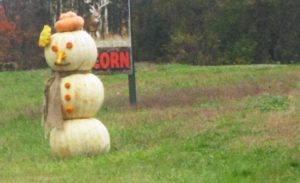
Say, good night, Pumpkin Person. (A pumpkin person at the Red Wagon Farm Market on Route 33, Manalapan, Monmouth County.)
Joe Sapia, 60, is a lifelong resident of Monroe — in South Middlesex County, where his maternal family settled more than 100 years ago. He is a Pine Barrens naturalist and a gardener of organic vegetables and fruit, along with zinnias and roses. He draws inspiration on the Pine Barrens around Helmetta from his mother, Sophie Onda Sapia, who lived her whole life in these Pines, and his Polish-immigrant grandmother, Annie Poznanski Onda. He gardens the same backyard plot as did his Grandma Annie and Italian-American father, Joe Sr. Both are inspirations for his food gardening. Ma inspires his rose gardening. Joe is a semi-retired print journalist of almost 40 years. His work also is at @JosephSapia on Twitter.com, along with Facebook.com on the Jersey Midlands page.
Article and photos by Joe Sapia
Note: The yard references are to my house in the section of Monroe between Helmetta and Jamesburg in South Middlesex County. My yard is in a Pine Barrens outlier on the Inner Coastal Plain, the soil is loamy, and my neighborhood is on the boundary of Gardening Zones 6b (cooler) and 7a (warmer). Notes and photographs are for the period covered, unless otherwise noted.
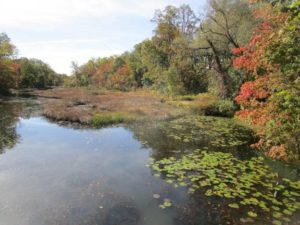
The fall foliage colors on Lawrence Brook in the Deans section of South Brunswick, Middlesex County.
FALL FOLIAGE: The peak of the colors is a little late this year, but this coming week should be very nice for viewing. The combination of fallen leaves and rain can make slippery driving conditions. So, be careful driving.
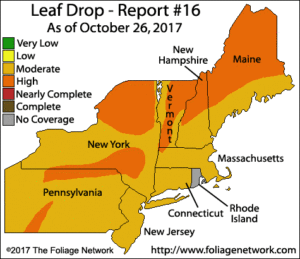
Northeastern United States fall foliage map. (Copyright 2017 by the Foliage Network.)
DEER RUT: Speaking of being careful when driving, look out for deer, “Odocoileus virginianus,” because the rut, or mating season, is on – meaning sex-crazed deer are running around. Normally, bucks stay out of sight, while it is common to see does and their brood. But over the last few weeks, I have noticed movement by bucks. During this week, I have seen a buck along the woods edge at Helmetta and in a driveway in a wooded area of East Brunswick, both in Middlesex County. If dividing the rut into three chapters of one, bucks challenging other bucks and chasing does, two, mating, and three, a wind-down, I would say we are in stage one on the cusp of stage two. The rut will extend to about mid-December.
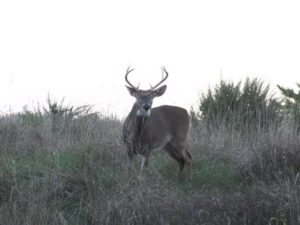
I shot this 7-point buck (with a camera) in 2015, October, just north of the Jersey Midlands near the Metropark railroad station area of Woodbridge, Middlesex County.
WINTER IS COMING: I have been gazing at the constellation Orion, easily identified in the night sky by its belt of three stars. When we can see Orion, it means we are in the colder weather part of the year. And cold weather means being on the lookout for snow. On 2008, October 28, it snowed in the Helmetta area of Middlesex County, but there was little, if any, accumulation. (The average snowfall in the New Brunswick, Middlesex County, area, for example, is 25.8 inches.)
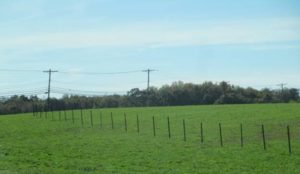
A sign of winter: fencing on farmland to prevent drifting snow. Here on a farm in Upper Freehold, Monmouth County, stakes for snowfencing are in place.
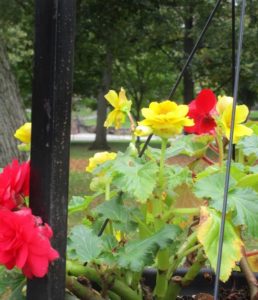
A little bit of lingering warm weather, a little taste of future cold weather — that is this time of year. Here, flowers in bloom on Voorhees Mall at Rutgers University—New Brunswick, Middlesex County.
“SNOWBIRDS”: Has anyone seen the first “snowbird,” or junco, “Junco hyemalis,” of the cold-weather season? I have not noticed any yet, but likely will see one soon, because I normally see the first one of the season around Halloween.
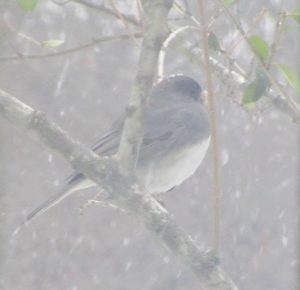
A “snowbird” in my yard in March of this year. They are a cold-weather bird in the Jersey Midlands. Normally, I begin seeing them around Halloween.
BIRD-FEEDING: For the first time in years, I did not feed birds this summer. Although I love zoning out and watching birds at my backyard feeder, I decided to put the birds visiting my yard to work, that is, eating insects – and from my end, saving money on birdseed. But this week, with food gardening pretty much over for the year and cold weather scaring off insects, I resumed feeding. It seemed to take a few days to attract birds to the feeder, but they are now there – blue jay, “Cyanocitta cristata”; chickadee, probably “Poecile carolinensis”; titmouse, “Baeolophus bicolor”; and nuthatch, “Sitta carolinensis.” And I await more species.
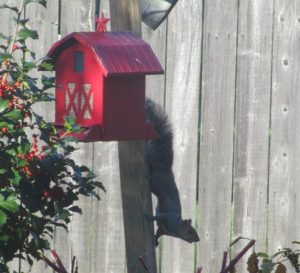
A gray squirrel, “Sciurus carolinensis,” testing the squirrel guard on my backyard birdfeeder. I will have to keep an eye on it to see who wins, feeder or squirrel.
DRY CONDITIONS: All of the Jersey Midlands’s seven counties are below average for rain over the last three months. Through October 27, Friday, Hunterdon received 8.5 inches, down 4.0 inches; Somerset, 9.6 inches, down 2.7 inches; Middlesex, 10.0 inches, down 2.1 inches; Mercer, 7.5 inches, down 4.5 inches; Monmouth, 8.2 inches, down 3.5 inches; Ocean, 9.0 inches, down 2.4 inches; and Burlington, 9.4 inches, down 2.4 inches.

Middlesex County’s Farrington Lake is low. Here, looking from the South Brunswick-East Brunswick boundary across the lake to North Brunswick.
THE WIND: On the morning of Tuesday, October 24, I went to the Helmetta Post Office, where I am third generation with Box 275, to pick up my mail. There, I noticed American flags at the Fire Department and at the historic Avon Inn snapping in the wind. Judging by the flags, the wind was blowing up to 8 to 12 miles per hour. Wind speed can be judged by its impact on flags, trees, and smoke, for example.
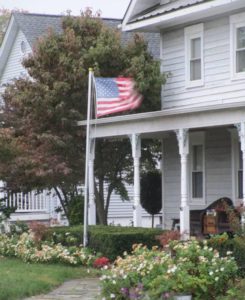
An American flag snaps to the wind at Helmetta’s historic Avon Inn, now a private residence. It dates back as a circa late 1800s-early 1900s inn positioned near a railroad station. (Think of the hotel on the 1963-1970 television sitcom “Petticoat Junction.”)
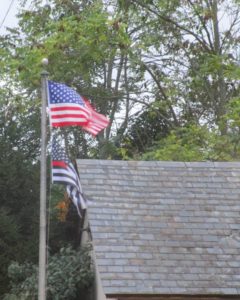
Another American flag in the wind at the Helmetta firehouse and old George W. Helme Snuff Mill pumphouse, which sits on the mill race leading from the former mill to Manalapan Brook.

This is an easy-to-use wind chart from universetoday.com. (Graphic copyright 2017 by universetoday.com.)
CLOUDS OVER NEW BRUNSWICK: During a break from my work in the Plangere Writing Center at Rutgers University’s Murray Hall in New Brunswick, Middlesex County, I looked out a window and noticed the clouds over the Johnson and Johnson pharmaceutical company headquarters along the Raritan River. Again, a beautiful display by Mother Nature:

Clouds over Johnson and Johnson pharmaceuticals headquarters along the Raritan River in New Brunswick, Middlesex County. Photograph from Murray Hall on the Rutgers University downtown campus.
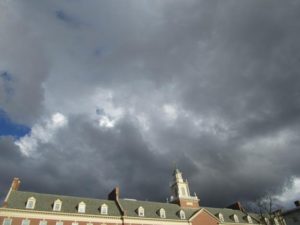
Another photo of clouds over the J&J building in New Brunswick, Middlesex County.
LOST MAN IN THE PINE BARRENS AROUND HELMETTA: A 68-year-old was rescued after becoming lost and weakened during a walk in an East Brunswick, Middlesex County, section of the Jamesburg Park Conservation Area. The man apparently was not physically injured. But he had suffered a stroke about 10 years ago and has physical, cognitive, and speech limitations, according to family friends and officials. Rescuers first had to locate the man. Then, those rescuers were lost and had to be guided out of the woods. A State Police helicopter was called in to light up the woods and find the victim and his rescuers. The helicopter, then, guided them out before it had to leave because it was low on fuel. The rescue took about four hours until about 9:30 p.m. Because of the swampy and woodsy terrain, the man had to be hand-carried out on a stretcher. The Jamesburg Conservation Area, which is owned by Middlesex County Parks and Recreation, is about 1,400 acres of woods, swamp, waterways, and bodies of water, including Helmetta Pond.
HELMETTA POND, GOOD FOR THE SOUL: Ralph “Rusty” Richards, a mentor of mine in the Pine Barrens around Helmetta, Middlesex County, and I were talking at Helmetta Pond when this unfamiliar woman walked by and told us she was going to wet her feet in the Pond. It sure looked good for the soul.
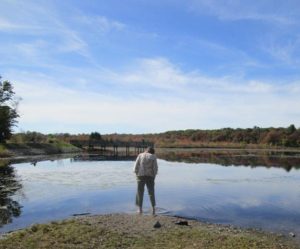
Wading woman at Helmetta Pond.
DRIVE-BY FARM SCENES: In my travels, I photographed various farm scenes in South Brunswick and Monroe, both in Middlesex County, and Upper Freehold, Monmouth County.
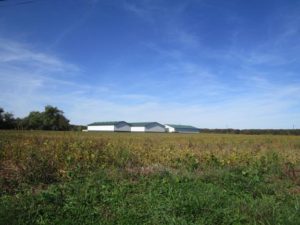
A farm in South Brunswick, Middlesex County.
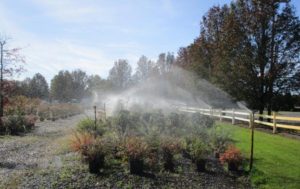
Lark Nurseries in Monroe, Middlesex County.
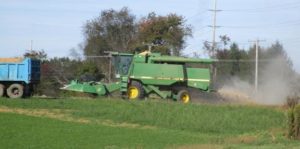
A combine works a field in Upper Freehold, Monmouth County.

Irrigation equipment on a sod farm in Upper Freehold, Monmouth County.
OCEAN TEMPERATURES: Atlantic Ocean temperatures on the New Jersey coast were about 61 degrees to 64 degrees on the October 28-29 weekend.
CHANGE THE CLOCKS: We switch from Daylight Savings Time to Standard Time November 5, Sunday, at 2 a.m., the clocks moving back to 1 a.m.
SUNRISE/SUNSET: For October 29, Sunday, to November 4, Saturday, the sun will rise about 7:25 to 7:30 a.m. and set about 5:55 p.m. For November 5, Sunday, to November 11, Saturday, the sun will rise about 6:35 a.m. set about 4:45 p.m.
WEATHER: The National Weather Service forecasting station for the area is at http://www.weather.gov/phi/.
THE NIGHT SKY: The next full moon is the Frost Moon on the Friday-Saturday, November 3-4, overnight.
“WAR OF THE WORLDS” BROADCAST: When you look into the night sky, something may be looking back… On 1938, October 30, Mischief Night, the Jersey Midlands were invaded by Martians in Orson Welles and the Mercury Theatre on the Air’s adaptation of H.G. Wells’s “The War of the Worlds.” The broadcast, https://www.youtube.com/watch?v=9q7tN7MhQ4I.
UPCOMING: October 29, Sunday, 1:30 p.m., from Clean Ocean Action: “There will be a commemoration of lives, homes and businesses lost as a result of (2012’s) Superstorm Sandy. There will be a rally followed by brief comments from various elected officials and the major candidates for Governor. Attendees will line the Asbury Park boardwalk from end to end demonstrating the urgent need to address climate change. The call to action will be captured by aerial photography as attendees hold hands across the boardwalk. For more information or to get involved, contact Ed Potosnak, NJ League of Conservation Voters at ed.potosnak@njlcv.org. RSVP today at njlcvef.org/sandy.”

A tree eats a traffic sign in South Brunswick, Middlesex County.
Joe Sapia, 60, is a lifelong resident of Monroe in South Middlesex County. He is a Pine Barrens naturalist and a gardener of organic vegetables and fruit, along with zinnias and roses. He draws inspiration on the Pine Barrens around Helmetta from his mother, Sophie Onda Sapia, who lived her whole life in these Pines, and his Polish-immigrant grandmother, Annie Poznanski Onda. He gardens the same backyard plot as did his Italian-American father, Joe Sr., and Grandma Annie. Both are inspirations for his food gardening. Ma inspires his rose gardening. Joe’s work also is at @JosephSapia on Twitter.com, along with Facebook.com on the Jersey Midlands page.
Article and photos by Joe Sapia
Note: The yard references are to my house in the section of Monroe between Helmetta and Jamesburg in South Middlesex County. My yard is in a Pine Barrens outlier on the Inner Coastal Plain, the soil is loamy, and my neighborhood is on the boundary of Gardening Zones 6b (cooler) and 7a (warmer). Notes and photographs are for the period covered, unless otherwise noted.

A bit of a strange scene in my backyard: forsythia blooming among the fall foliage changing of colors.
SPRING IN THE FALL: Years ago, I recall seeing sheep laurel, “Kalmia angustifolia,” a spring bloomer, flowering in the fall in the Pine Barrens around Helmetta. Twice this week, I noticed a bird or birds singing away, seemingly a springtime song; And a red-bellied woodpecker, “Melanerpes carolinus,” drummed against my house. Also, this week, I noticed another spring bloomer in flower – forsythia. It flowered in my backyard. I normally see forsythia blooming for the first time of the season in early March to mid-April. What does it all mean? I just think the fall conditions are replicating spring conditions, especially the summerlike temperatures.

The backyard forsythia in bloom.
THE PINE BARRENS “FALL FOLIAGE” PEAK: The Pine Barrens’s name is a misnomer, neither a place of all pines nor barren lands. And it is a great place to see the changing colors of the fall foliage – the deciduous vegetation changes, with blueberry bushes turning flaming red, and contrasts with the greens of pines, cedars, and laurels. Normally, I look for the fall foliage color peak in the Pine Barrens on October 13 in the wetlands and October 20 in the uplands. This year, that schedule is running behind. The woods around Helmetta are still quite green. (“Fall foliage” is a misnomer, too. In the Pine Barrens around Helmetta, one can observe the changing colors beginning in about mid- to late July.)

The colors are changing at Helmetta Pond October 13, Friday, but not yet peaking
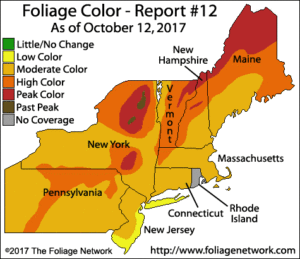
An October 12, Thursday, map from the Fall Foliage Network.
DRIVE-BY NATURALIST, PHEASANT: I just happened to be reading about ring-necked pheasants, “Phasianus colchicus,” the other day. Then, I saw one between the Applegarth and Wyckoff Mills section of Monroe, Middlesex County, the first time I recall seeing one afield in maybe 20 or 25 years. These are non-native – introduced to America from Asia in the 1880s, according to Cornell University’s All About Birds website, allaboutbirds.org. Now, they are naturalized in the United States. This one could have been a naturalized bird or one released for hunting.
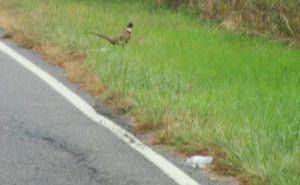
This is a rather blurry photograph, because I came across this ring-necked pheasant unexpectedly while I was driving and had to quickly crank off a photograph before it fled. I am using this photo because it shows a full view of the bird. Also, I did not crop out the roadside litter, to illustrate how wildlife competes with human carelessness.
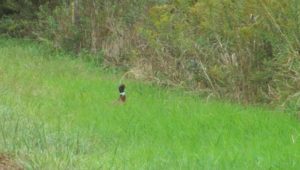
Notice the white, forming the ring around its neck.
CLOUDS: This week’s spectacular cloud scene was in Middlesex County, at North Brunswick, looking toward Milltown. I stopped at the McDonald’s restaurant for breakfast, looked at the sky, and there they were.

Clouds over North Brunswick, Middlesex County.
VOICES FROM (FAR) AFIELD, JUDY AUER SHAW: Judy Auer Shaw, author of “The Raritan River, Our Landscape, Our Legacy,” checked in from Ohio, reminded by a suggestion in a previous “Garden and Afield” to wear blaze orange in the woods in hunting areas: “I have a story from my teaching years in Michigan. I organized a nature hike for my kids (7th graders) and we all wore browns, grays and greens. As we approached the hiking trail, we were behind a carload of guys wearing orange. It finally dawned on me that we were going out on the first day of hunting season — in complete camouflage. Yikes! Needless to say, we were fine, but I was one worried den mother that day!”

Judy Auer Shaw’s 2014 book.
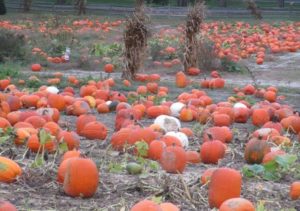
The pumpkin patch at Giamarese Farm on Fresh Ponds Road, East Brunswick, Middlesex County
YARD AND GARDEN: I planted five “false cypress,” or Crippsii,” I picked up at Krygier’s Nursery in South Brunswick, Middlesex County. The Knock Out roses and zinnias continue blooming – the zinnias being visited by such butterflies as the painted lady, “Vanessa virginiensis,” and cabbage white, “Pieris rapae.” Despite blooming, the zinnias are losing their luster, covered with powdery mildew, “Golovinomyces cichoracearum,” and a leaf spot disease. I also found my first raspberry on some bushes planted earlier this year.

Five “false cypress,” or Crippsii, have been added to my yard.
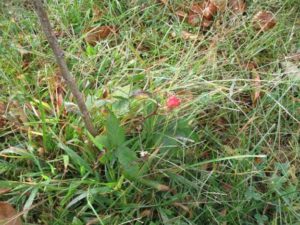
A raspberry fruiting in my backyard garden.
FARMING PERILS IN THE MIDLANDS: I was visiting Krygier’s Nursery, owned by husband and wife Jimmy Krygier, in South Brunswick, Middlesex County, and two perils were obvious – encroaching development and damage caused by browsing deer, “Odocoileus virginianus.” The nursery, a Krygier family business for three generations of about 100 years, is on Route 535, also known as Cranbury-South River Road, Cranbury Road, and South River Road. What was adjoining cornfield up to months ago is now a warehouse property, for example. And one only has to see how the deer have shaped the arbor vitae trees through their browsing. (Krygier’s Nursery is at the corner of Route 535 and Dunham’s Corner Road, South Brunswick, near the Middlesex County Fair Grounds).

Development encroaches Krygier’s Nursery in South Brunswick, Middlesex County.

Notice the odd shape to the arbor vitae. It is caused by deer nibbling on the trees.
DEER DOCUMENTARY: “The Deer Stand” is a documentary about deer over-population in the Jersey Midlands. See the movie at https://vimeo.com/233572156.

In fall of 2016, Anna Luiten, an ecologist with the Monmouth County Park System, stands in a Thompson Park forest area over-browsed by deer. The fenced area contains a lush understory, because it is protected from deer.
SNOWBIRDS: Anybody seeing dark-eyed juncos, or “snowbirds,” yet? The birds, “Junco hyemalis,” come down to our area from as far away as Canada during the cold-weather months. I normally begin seeing them in my yard around Halloween. Their color pattern of slate gray on their backs and white on their fronts suggests, “Dark skies above, snow below.”
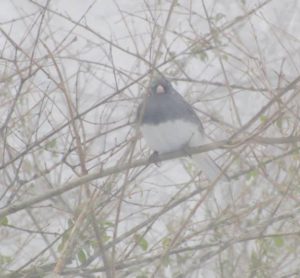
A “snowbird” in the snow in my yard in early 2017.
OCEAN TEMPERATURES: Atlantic Ocean temperatures on the New Jersey coast were about 67 degrees to 69 degrees during the October 14-15 weekend.
SUNRISE/SUNSET: For October 15, Sunday, to October 21, Saturday, the sun will rise from about 7:10 to 7:15 a.m. and set about 6:10 to 6:15 p.m. For October 22, Sunday, to October 28, Saturday, the sun will rise about 7:20 a.m. and set about 6 a.m. to 6:05 a.m. We switch to Daylight Savings Time November 5, Sunday, at 2 a.m., the clocks moving back to 1 a.m.
THE NIGHT SKY: The next full moon is the Frost Moon on the November 3-4 overnight.
WEATHER: The National Weather Service forecasting station for the area is at http://www.weather.gov/phi/.
UPCOMING: 2017, October 28, Saturday, 1 p.m. book signing and 2 p.m. lecture with Marta McDowell, author of “Beatrix Potter’s Gardening Life,” at Jamesburg Presbyterian Church, 175 Gatzmer Ave, Jamesburg. $30 at the door. More information is available from the Earth Center Conservancy (of Middlesex County), www.ecc-nj.com. Beatrix Potter, born in 1866 and died in 1943, was a children’s writer and illustrator. She wrote and illustrated “The Tale of Peter Rabbit,” 1901.

Author Marta McDowell will sign books and speak in Jamesburg, Middlesex County, October 28, Saturday.

Gray squirrels, “Sciurus carolinensis,” appear to be active, burying acorns, preparing for winter. This one was at Rutgers University’s College Avenue Campus in New Brunswick, Middlesex County.
Joe Sapia, 60, is a lifelong Monroe resident. He is a Pine Barrens naturalist and an organic vegetable-fruit gardener. He gardens the same backyard plot as did his Italian-American father, Joe Sr., and his Polish-immigrant, maternal grandmother, Annie Poznanski Onda. Both are inspirations for his food gardening. He draws inspiration on the Pine Barrens around Helmetta from his mother, Sophie Onda Sapia, who lived her whole life in these Pines, and his Grandma Annie. Joe’s work also is at @JosephSapia on Twitter.com, along with Facebook.com on the Jersey Midlands page.


































































































































































